Human Resource Management
VerifiedAdded on 2023/04/23
|31
|5835
|148
AI Summary
This document covers various aspects of Human Resource Management including recruitment and selection, orientation, maintaining good working conditions, managing employee relations, training and development, importance of strategic HRM planning, Fair Work Act 2009, employee record keeping, advantages and disadvantages of different recruitment methods, minutes of a meeting of the Human Resources Committee, HR Action Plan Sample and Recruitment Strategies.
Contribute Materials
Your contribution can guide someone’s learning journey. Share your
documents today.
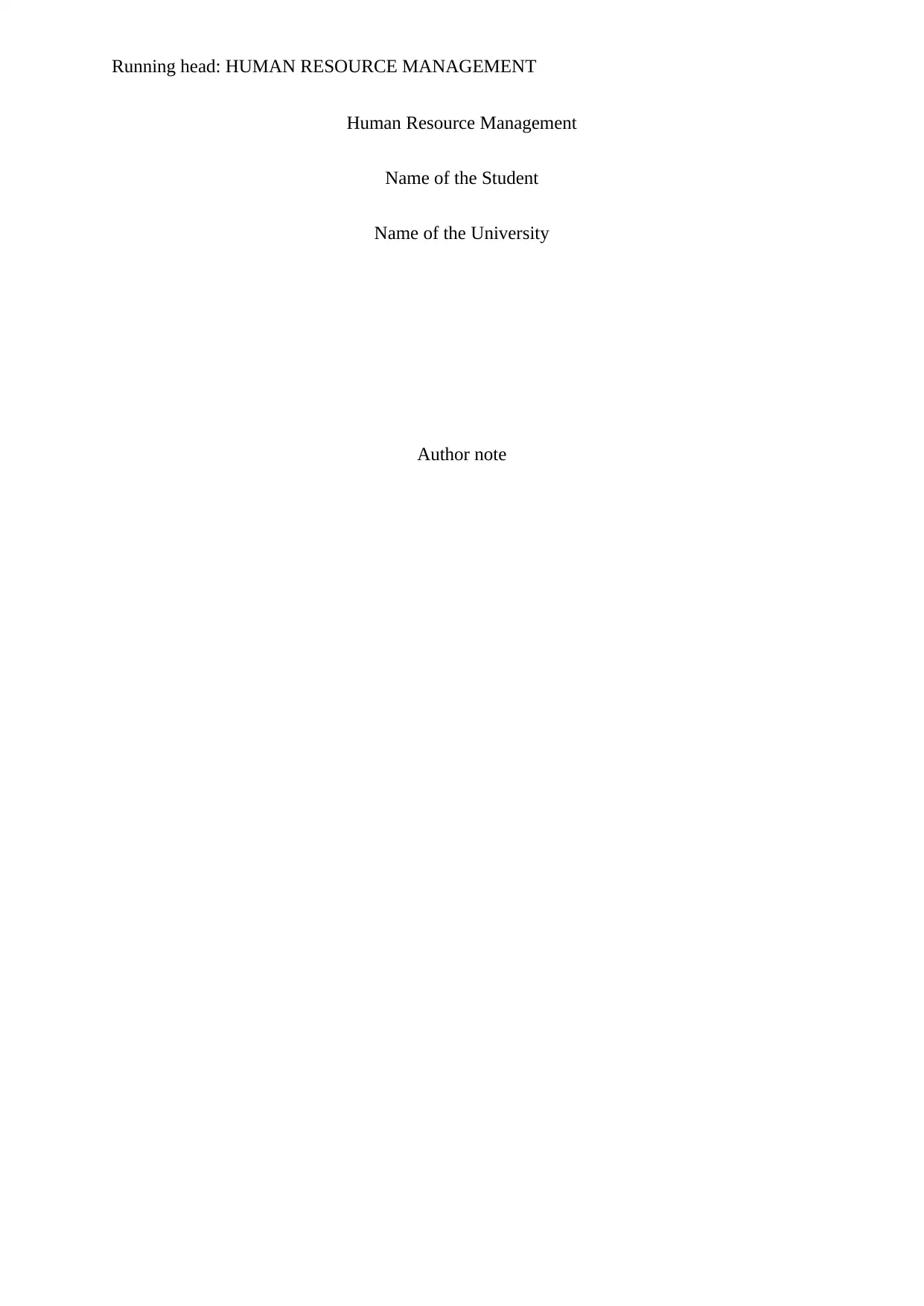
Running head: HUMAN RESOURCE MANAGEMENT
Human Resource Management
Name of the Student
Name of the University
Author note
Human Resource Management
Name of the Student
Name of the University
Author note
Secure Best Marks with AI Grader
Need help grading? Try our AI Grader for instant feedback on your assignments.
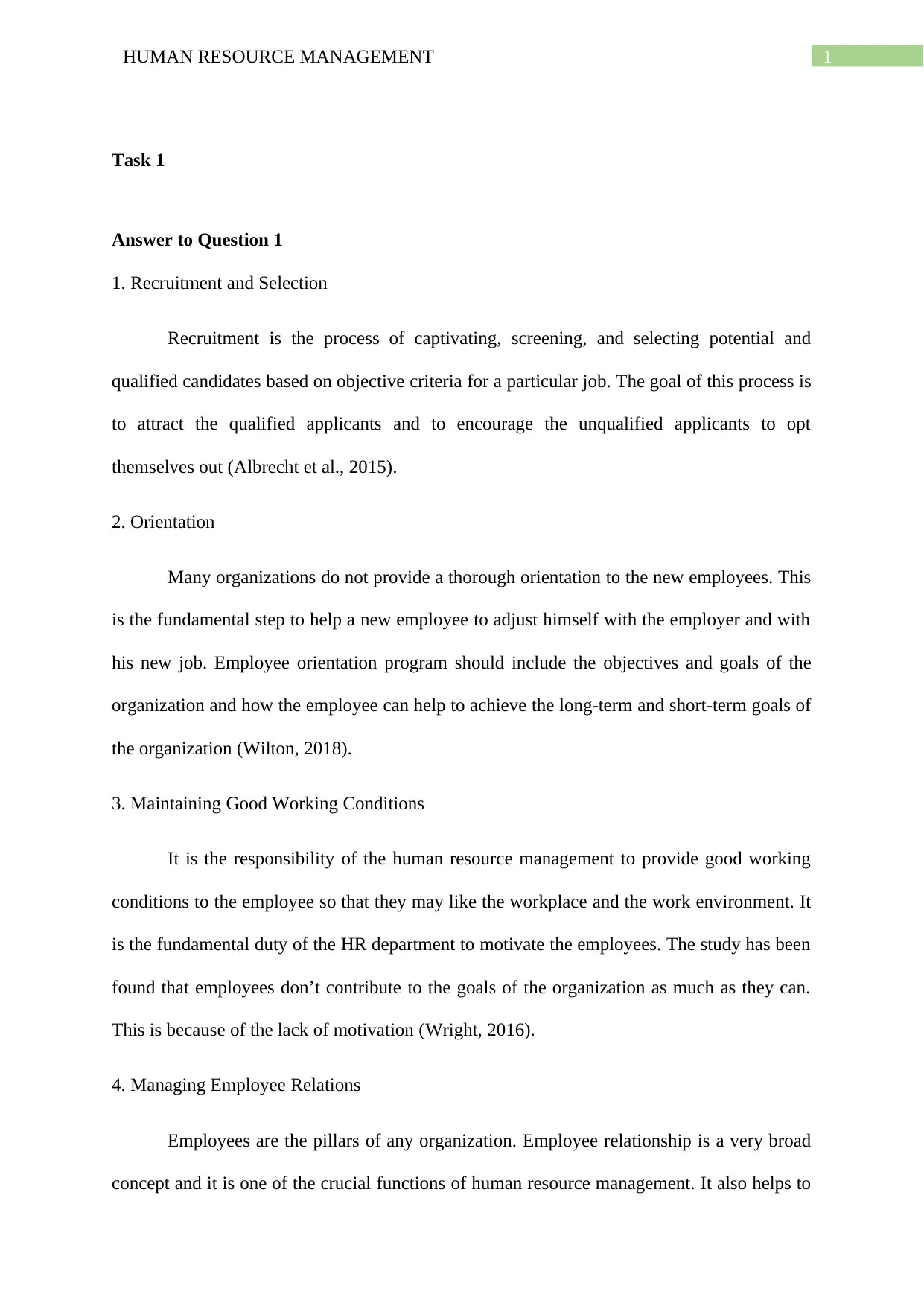
1HUMAN RESOURCE MANAGEMENT
Task 1
Answer to Question 1
1. Recruitment and Selection
Recruitment is the process of captivating, screening, and selecting potential and
qualified candidates based on objective criteria for a particular job. The goal of this process is
to attract the qualified applicants and to encourage the unqualified applicants to opt
themselves out (Albrecht et al., 2015).
2. Orientation
Many organizations do not provide a thorough orientation to the new employees. This
is the fundamental step to help a new employee to adjust himself with the employer and with
his new job. Employee orientation program should include the objectives and goals of the
organization and how the employee can help to achieve the long-term and short-term goals of
the organization (Wilton, 2018).
3. Maintaining Good Working Conditions
It is the responsibility of the human resource management to provide good working
conditions to the employee so that they may like the workplace and the work environment. It
is the fundamental duty of the HR department to motivate the employees. The study has been
found that employees don’t contribute to the goals of the organization as much as they can.
This is because of the lack of motivation (Wright, 2016).
4. Managing Employee Relations
Employees are the pillars of any organization. Employee relationship is a very broad
concept and it is one of the crucial functions of human resource management. It also helps to
Task 1
Answer to Question 1
1. Recruitment and Selection
Recruitment is the process of captivating, screening, and selecting potential and
qualified candidates based on objective criteria for a particular job. The goal of this process is
to attract the qualified applicants and to encourage the unqualified applicants to opt
themselves out (Albrecht et al., 2015).
2. Orientation
Many organizations do not provide a thorough orientation to the new employees. This
is the fundamental step to help a new employee to adjust himself with the employer and with
his new job. Employee orientation program should include the objectives and goals of the
organization and how the employee can help to achieve the long-term and short-term goals of
the organization (Wilton, 2018).
3. Maintaining Good Working Conditions
It is the responsibility of the human resource management to provide good working
conditions to the employee so that they may like the workplace and the work environment. It
is the fundamental duty of the HR department to motivate the employees. The study has been
found that employees don’t contribute to the goals of the organization as much as they can.
This is because of the lack of motivation (Wright, 2016).
4. Managing Employee Relations
Employees are the pillars of any organization. Employee relationship is a very broad
concept and it is one of the crucial functions of human resource management. It also helps to
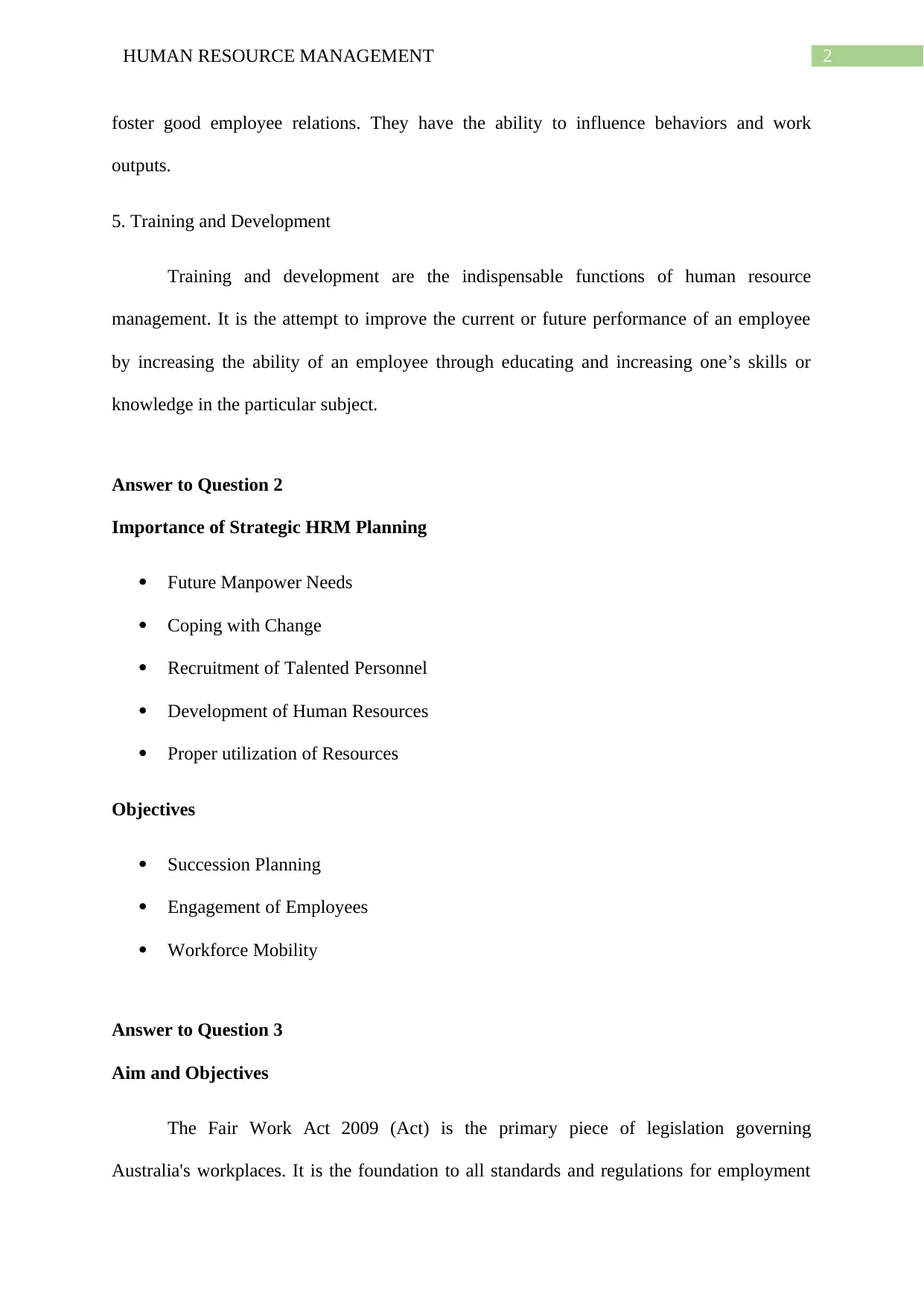
2HUMAN RESOURCE MANAGEMENT
foster good employee relations. They have the ability to influence behaviors and work
outputs.
5. Training and Development
Training and development are the indispensable functions of human resource
management. It is the attempt to improve the current or future performance of an employee
by increasing the ability of an employee through educating and increasing one’s skills or
knowledge in the particular subject.
Answer to Question 2
Importance of Strategic HRM Planning
Future Manpower Needs
Coping with Change
Recruitment of Talented Personnel
Development of Human Resources
Proper utilization of Resources
Objectives
Succession Planning
Engagement of Employees
Workforce Mobility
Answer to Question 3
Aim and Objectives
The Fair Work Act 2009 (Act) is the primary piece of legislation governing
Australia's workplaces. It is the foundation to all standards and regulations for employment
foster good employee relations. They have the ability to influence behaviors and work
outputs.
5. Training and Development
Training and development are the indispensable functions of human resource
management. It is the attempt to improve the current or future performance of an employee
by increasing the ability of an employee through educating and increasing one’s skills or
knowledge in the particular subject.
Answer to Question 2
Importance of Strategic HRM Planning
Future Manpower Needs
Coping with Change
Recruitment of Talented Personnel
Development of Human Resources
Proper utilization of Resources
Objectives
Succession Planning
Engagement of Employees
Workforce Mobility
Answer to Question 3
Aim and Objectives
The Fair Work Act 2009 (Act) is the primary piece of legislation governing
Australia's workplaces. It is the foundation to all standards and regulations for employment
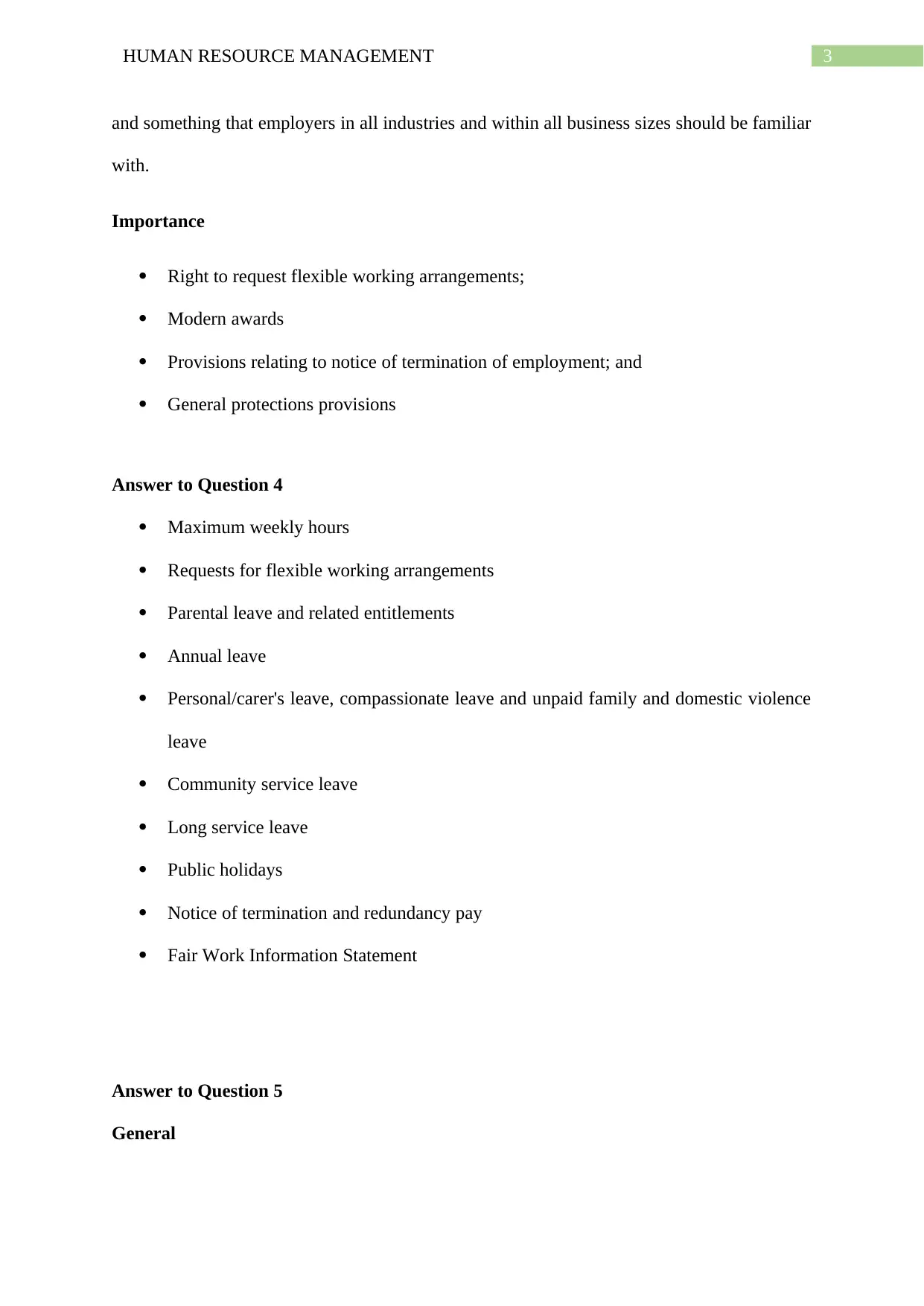
3HUMAN RESOURCE MANAGEMENT
and something that employers in all industries and within all business sizes should be familiar
with.
Importance
Right to request flexible working arrangements;
Modern awards
Provisions relating to notice of termination of employment; and
General protections provisions
Answer to Question 4
Maximum weekly hours
Requests for flexible working arrangements
Parental leave and related entitlements
Annual leave
Personal/carer's leave, compassionate leave and unpaid family and domestic violence
leave
Community service leave
Long service leave
Public holidays
Notice of termination and redundancy pay
Fair Work Information Statement
Answer to Question 5
General
and something that employers in all industries and within all business sizes should be familiar
with.
Importance
Right to request flexible working arrangements;
Modern awards
Provisions relating to notice of termination of employment; and
General protections provisions
Answer to Question 4
Maximum weekly hours
Requests for flexible working arrangements
Parental leave and related entitlements
Annual leave
Personal/carer's leave, compassionate leave and unpaid family and domestic violence
leave
Community service leave
Long service leave
Public holidays
Notice of termination and redundancy pay
Fair Work Information Statement
Answer to Question 5
General
Secure Best Marks with AI Grader
Need help grading? Try our AI Grader for instant feedback on your assignments.
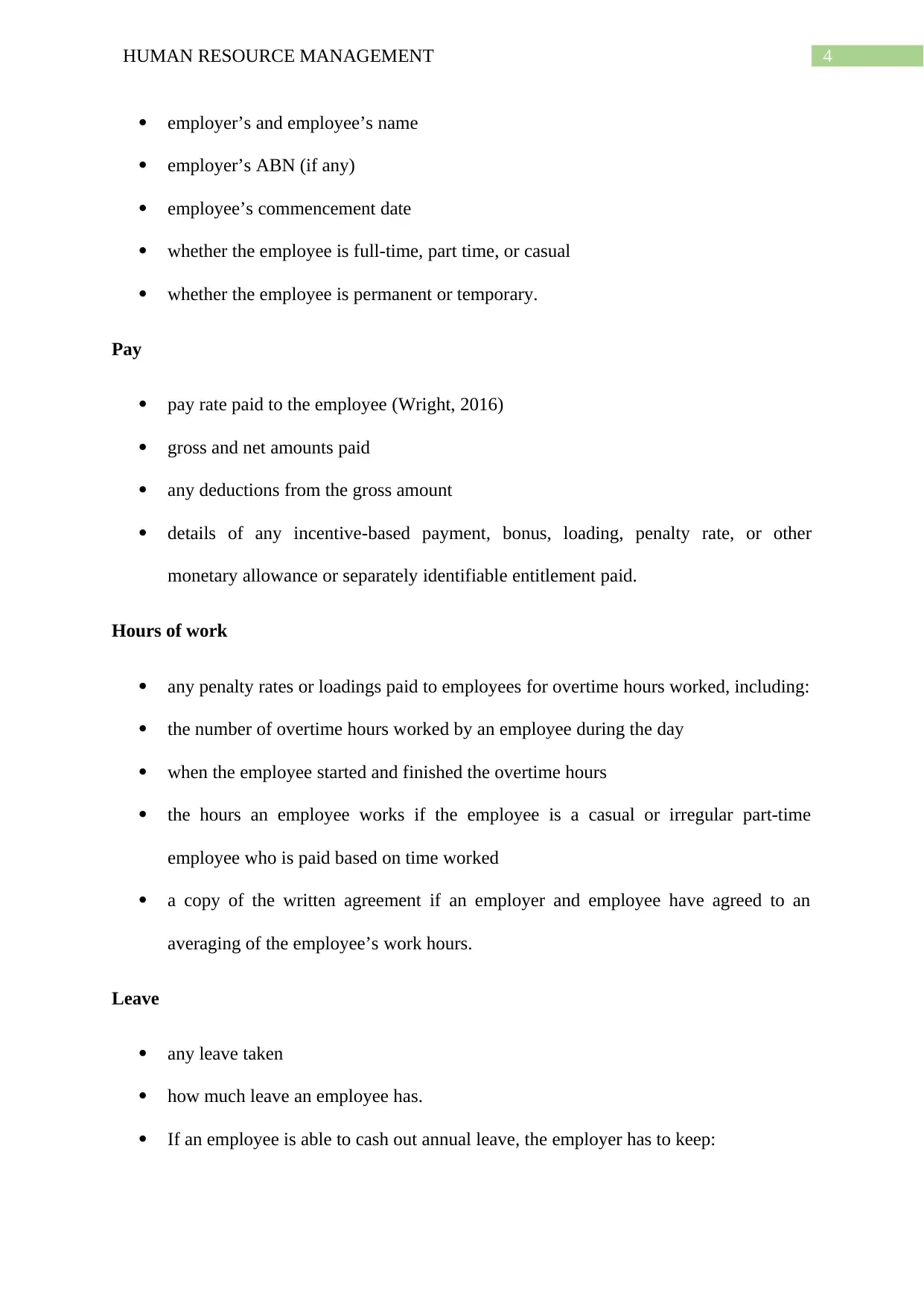
4HUMAN RESOURCE MANAGEMENT
employer’s and employee’s name
employer’s ABN (if any)
employee’s commencement date
whether the employee is full-time, part time, or casual
whether the employee is permanent or temporary.
Pay
pay rate paid to the employee (Wright, 2016)
gross and net amounts paid
any deductions from the gross amount
details of any incentive-based payment, bonus, loading, penalty rate, or other
monetary allowance or separately identifiable entitlement paid.
Hours of work
any penalty rates or loadings paid to employees for overtime hours worked, including:
the number of overtime hours worked by an employee during the day
when the employee started and finished the overtime hours
the hours an employee works if the employee is a casual or irregular part-time
employee who is paid based on time worked
a copy of the written agreement if an employer and employee have agreed to an
averaging of the employee’s work hours.
Leave
any leave taken
how much leave an employee has.
If an employee is able to cash out annual leave, the employer has to keep:
employer’s and employee’s name
employer’s ABN (if any)
employee’s commencement date
whether the employee is full-time, part time, or casual
whether the employee is permanent or temporary.
Pay
pay rate paid to the employee (Wright, 2016)
gross and net amounts paid
any deductions from the gross amount
details of any incentive-based payment, bonus, loading, penalty rate, or other
monetary allowance or separately identifiable entitlement paid.
Hours of work
any penalty rates or loadings paid to employees for overtime hours worked, including:
the number of overtime hours worked by an employee during the day
when the employee started and finished the overtime hours
the hours an employee works if the employee is a casual or irregular part-time
employee who is paid based on time worked
a copy of the written agreement if an employer and employee have agreed to an
averaging of the employee’s work hours.
Leave
any leave taken
how much leave an employee has.
If an employee is able to cash out annual leave, the employer has to keep:
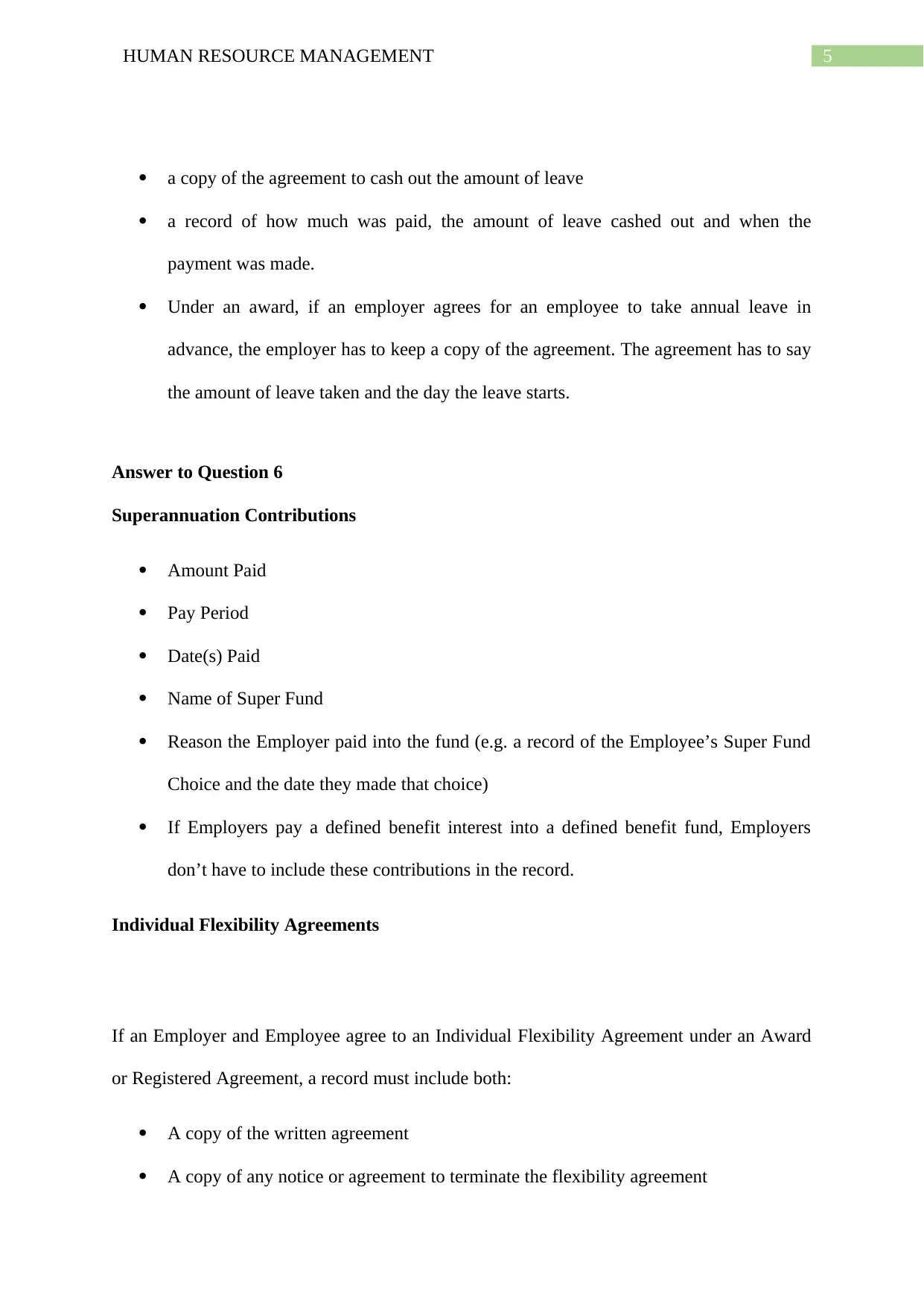
5HUMAN RESOURCE MANAGEMENT
a copy of the agreement to cash out the amount of leave
a record of how much was paid, the amount of leave cashed out and when the
payment was made.
Under an award, if an employer agrees for an employee to take annual leave in
advance, the employer has to keep a copy of the agreement. The agreement has to say
the amount of leave taken and the day the leave starts.
Answer to Question 6
Superannuation Contributions
Amount Paid
Pay Period
Date(s) Paid
Name of Super Fund
Reason the Employer paid into the fund (e.g. a record of the Employee’s Super Fund
Choice and the date they made that choice)
If Employers pay a defined benefit interest into a defined benefit fund, Employers
don’t have to include these contributions in the record.
Individual Flexibility Agreements
If an Employer and Employee agree to an Individual Flexibility Agreement under an Award
or Registered Agreement, a record must include both:
A copy of the written agreement
A copy of any notice or agreement to terminate the flexibility agreement
a copy of the agreement to cash out the amount of leave
a record of how much was paid, the amount of leave cashed out and when the
payment was made.
Under an award, if an employer agrees for an employee to take annual leave in
advance, the employer has to keep a copy of the agreement. The agreement has to say
the amount of leave taken and the day the leave starts.
Answer to Question 6
Superannuation Contributions
Amount Paid
Pay Period
Date(s) Paid
Name of Super Fund
Reason the Employer paid into the fund (e.g. a record of the Employee’s Super Fund
Choice and the date they made that choice)
If Employers pay a defined benefit interest into a defined benefit fund, Employers
don’t have to include these contributions in the record.
Individual Flexibility Agreements
If an Employer and Employee agree to an Individual Flexibility Agreement under an Award
or Registered Agreement, a record must include both:
A copy of the written agreement
A copy of any notice or agreement to terminate the flexibility agreement
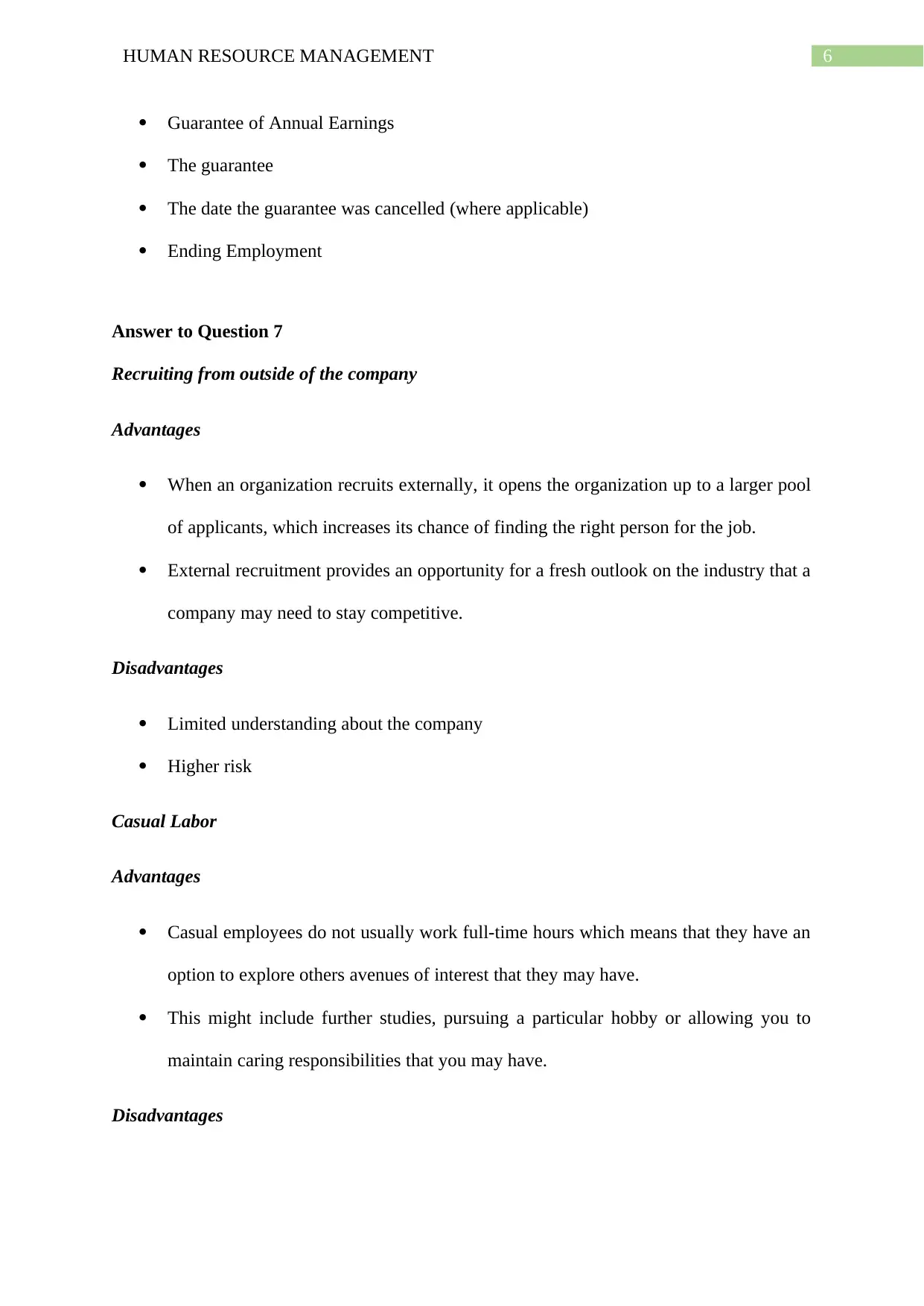
6HUMAN RESOURCE MANAGEMENT
Guarantee of Annual Earnings
The guarantee
The date the guarantee was cancelled (where applicable)
Ending Employment
Answer to Question 7
Recruiting from outside of the company
Advantages
When an organization recruits externally, it opens the organization up to a larger pool
of applicants, which increases its chance of finding the right person for the job.
External recruitment provides an opportunity for a fresh outlook on the industry that a
company may need to stay competitive.
Disadvantages
Limited understanding about the company
Higher risk
Casual Labor
Advantages
Casual employees do not usually work full-time hours which means that they have an
option to explore others avenues of interest that they may have.
This might include further studies, pursuing a particular hobby or allowing you to
maintain caring responsibilities that you may have.
Disadvantages
Guarantee of Annual Earnings
The guarantee
The date the guarantee was cancelled (where applicable)
Ending Employment
Answer to Question 7
Recruiting from outside of the company
Advantages
When an organization recruits externally, it opens the organization up to a larger pool
of applicants, which increases its chance of finding the right person for the job.
External recruitment provides an opportunity for a fresh outlook on the industry that a
company may need to stay competitive.
Disadvantages
Limited understanding about the company
Higher risk
Casual Labor
Advantages
Casual employees do not usually work full-time hours which means that they have an
option to explore others avenues of interest that they may have.
This might include further studies, pursuing a particular hobby or allowing you to
maintain caring responsibilities that you may have.
Disadvantages
Paraphrase This Document
Need a fresh take? Get an instant paraphrase of this document with our AI Paraphraser
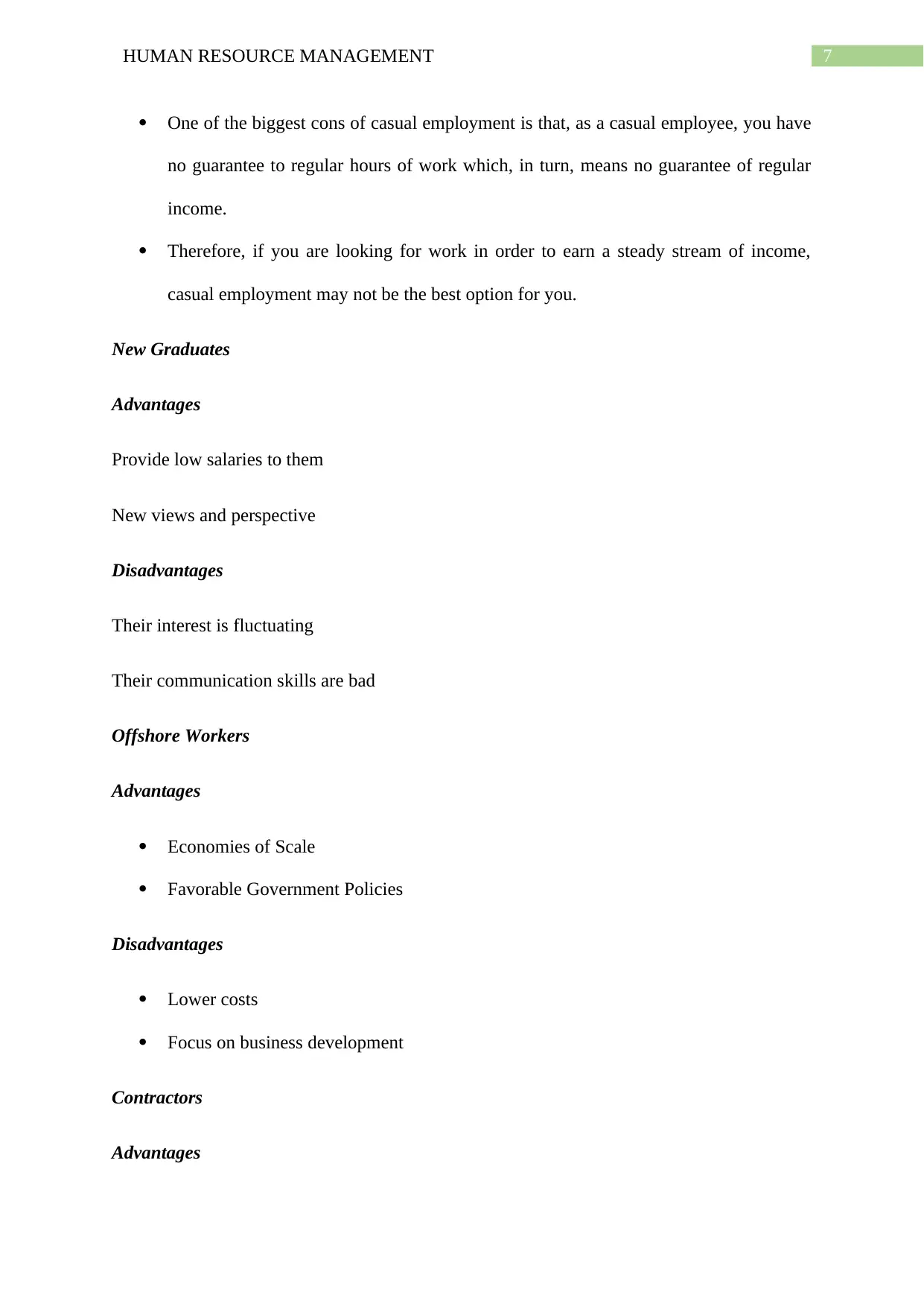
7HUMAN RESOURCE MANAGEMENT
One of the biggest cons of casual employment is that, as a casual employee, you have
no guarantee to regular hours of work which, in turn, means no guarantee of regular
income.
Therefore, if you are looking for work in order to earn a steady stream of income,
casual employment may not be the best option for you.
New Graduates
Advantages
Provide low salaries to them
New views and perspective
Disadvantages
Their interest is fluctuating
Their communication skills are bad
Offshore Workers
Advantages
Economies of Scale
Favorable Government Policies
Disadvantages
Lower costs
Focus on business development
Contractors
Advantages
One of the biggest cons of casual employment is that, as a casual employee, you have
no guarantee to regular hours of work which, in turn, means no guarantee of regular
income.
Therefore, if you are looking for work in order to earn a steady stream of income,
casual employment may not be the best option for you.
New Graduates
Advantages
Provide low salaries to them
New views and perspective
Disadvantages
Their interest is fluctuating
Their communication skills are bad
Offshore Workers
Advantages
Economies of Scale
Favorable Government Policies
Disadvantages
Lower costs
Focus on business development
Contractors
Advantages
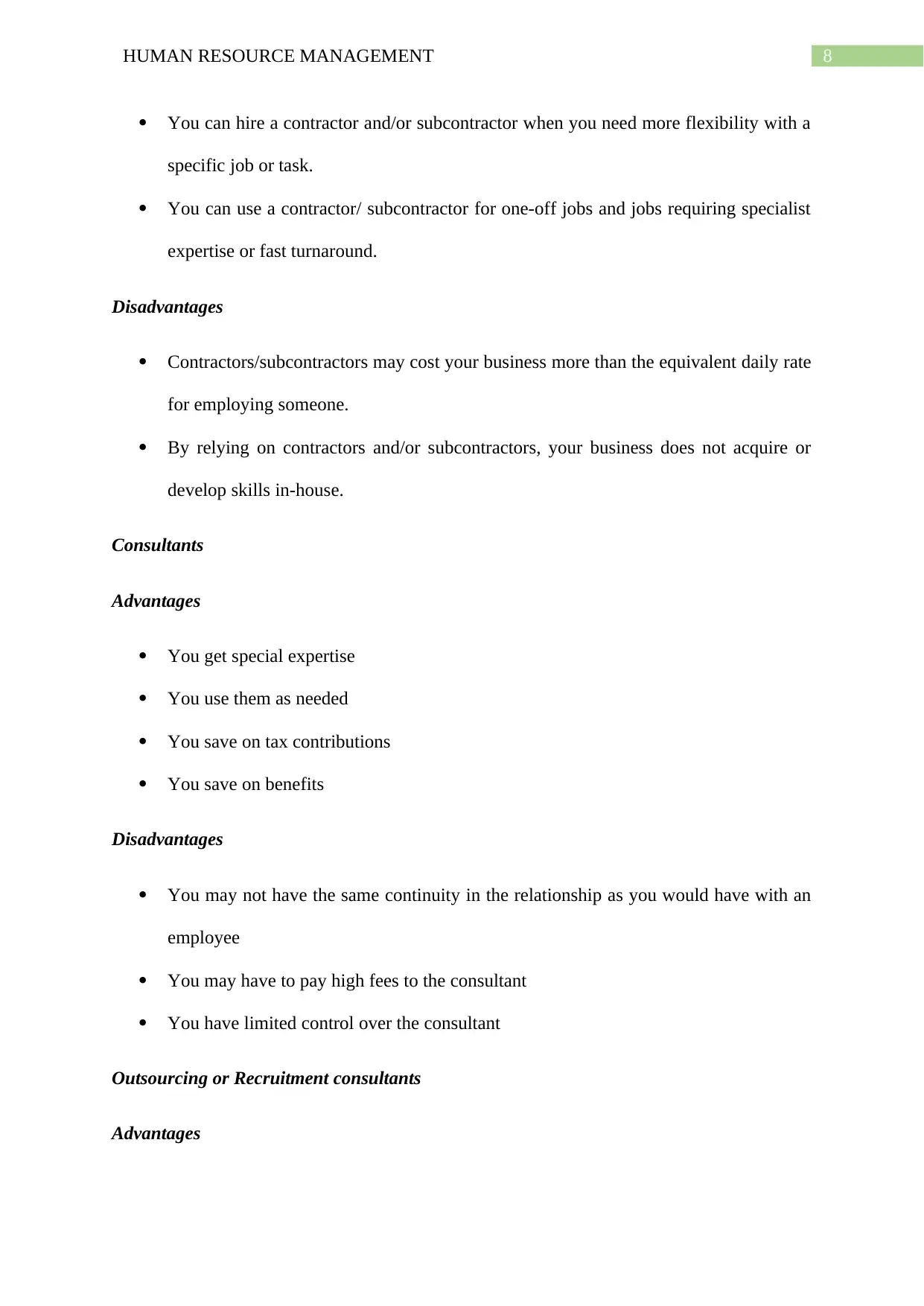
8HUMAN RESOURCE MANAGEMENT
You can hire a contractor and/or subcontractor when you need more flexibility with a
specific job or task.
You can use a contractor/ subcontractor for one-off jobs and jobs requiring specialist
expertise or fast turnaround.
Disadvantages
Contractors/subcontractors may cost your business more than the equivalent daily rate
for employing someone.
By relying on contractors and/or subcontractors, your business does not acquire or
develop skills in-house.
Consultants
Advantages
You get special expertise
You use them as needed
You save on tax contributions
You save on benefits
Disadvantages
You may not have the same continuity in the relationship as you would have with an
employee
You may have to pay high fees to the consultant
You have limited control over the consultant
Outsourcing or Recruitment consultants
Advantages
You can hire a contractor and/or subcontractor when you need more flexibility with a
specific job or task.
You can use a contractor/ subcontractor for one-off jobs and jobs requiring specialist
expertise or fast turnaround.
Disadvantages
Contractors/subcontractors may cost your business more than the equivalent daily rate
for employing someone.
By relying on contractors and/or subcontractors, your business does not acquire or
develop skills in-house.
Consultants
Advantages
You get special expertise
You use them as needed
You save on tax contributions
You save on benefits
Disadvantages
You may not have the same continuity in the relationship as you would have with an
employee
You may have to pay high fees to the consultant
You have limited control over the consultant
Outsourcing or Recruitment consultants
Advantages
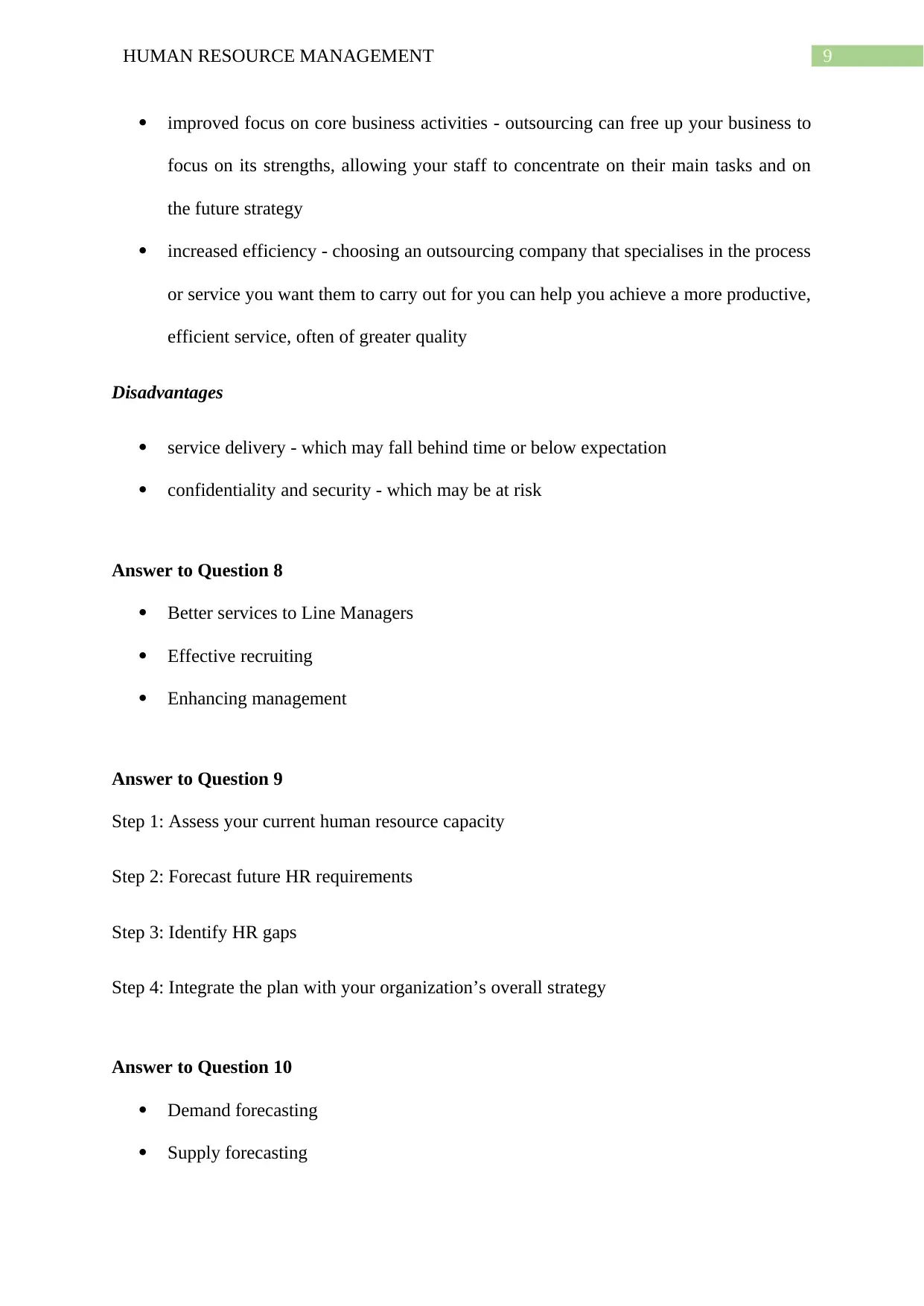
9HUMAN RESOURCE MANAGEMENT
improved focus on core business activities - outsourcing can free up your business to
focus on its strengths, allowing your staff to concentrate on their main tasks and on
the future strategy
increased efficiency - choosing an outsourcing company that specialises in the process
or service you want them to carry out for you can help you achieve a more productive,
efficient service, often of greater quality
Disadvantages
service delivery - which may fall behind time or below expectation
confidentiality and security - which may be at risk
Answer to Question 8
Better services to Line Managers
Effective recruiting
Enhancing management
Answer to Question 9
Step 1: Assess your current human resource capacity
Step 2: Forecast future HR requirements
Step 3: Identify HR gaps
Step 4: Integrate the plan with your organization’s overall strategy
Answer to Question 10
Demand forecasting
Supply forecasting
improved focus on core business activities - outsourcing can free up your business to
focus on its strengths, allowing your staff to concentrate on their main tasks and on
the future strategy
increased efficiency - choosing an outsourcing company that specialises in the process
or service you want them to carry out for you can help you achieve a more productive,
efficient service, often of greater quality
Disadvantages
service delivery - which may fall behind time or below expectation
confidentiality and security - which may be at risk
Answer to Question 8
Better services to Line Managers
Effective recruiting
Enhancing management
Answer to Question 9
Step 1: Assess your current human resource capacity
Step 2: Forecast future HR requirements
Step 3: Identify HR gaps
Step 4: Integrate the plan with your organization’s overall strategy
Answer to Question 10
Demand forecasting
Supply forecasting
Secure Best Marks with AI Grader
Need help grading? Try our AI Grader for instant feedback on your assignments.
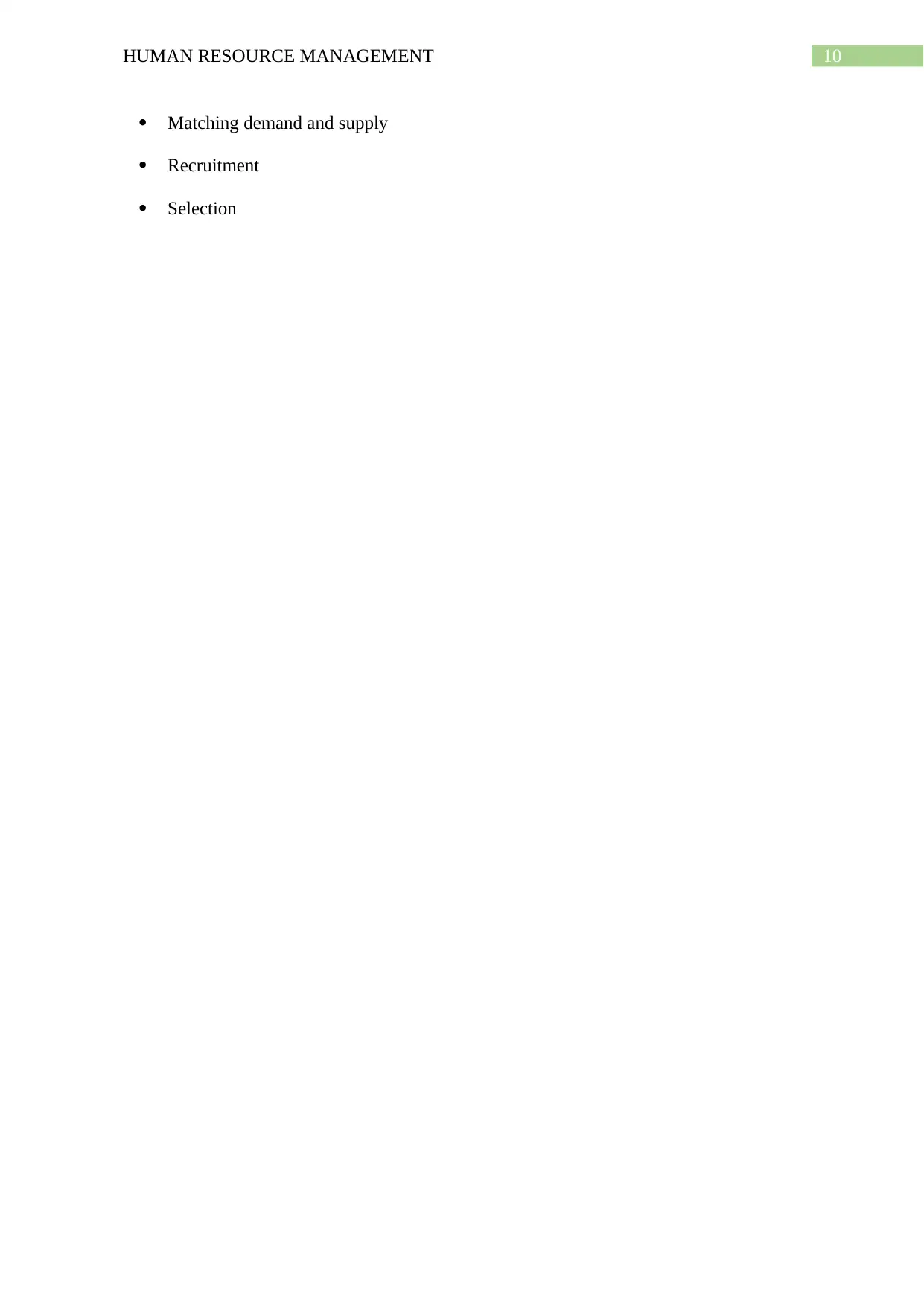
10HUMAN RESOURCE MANAGEMENT
Matching demand and supply
Recruitment
Selection
Matching demand and supply
Recruitment
Selection
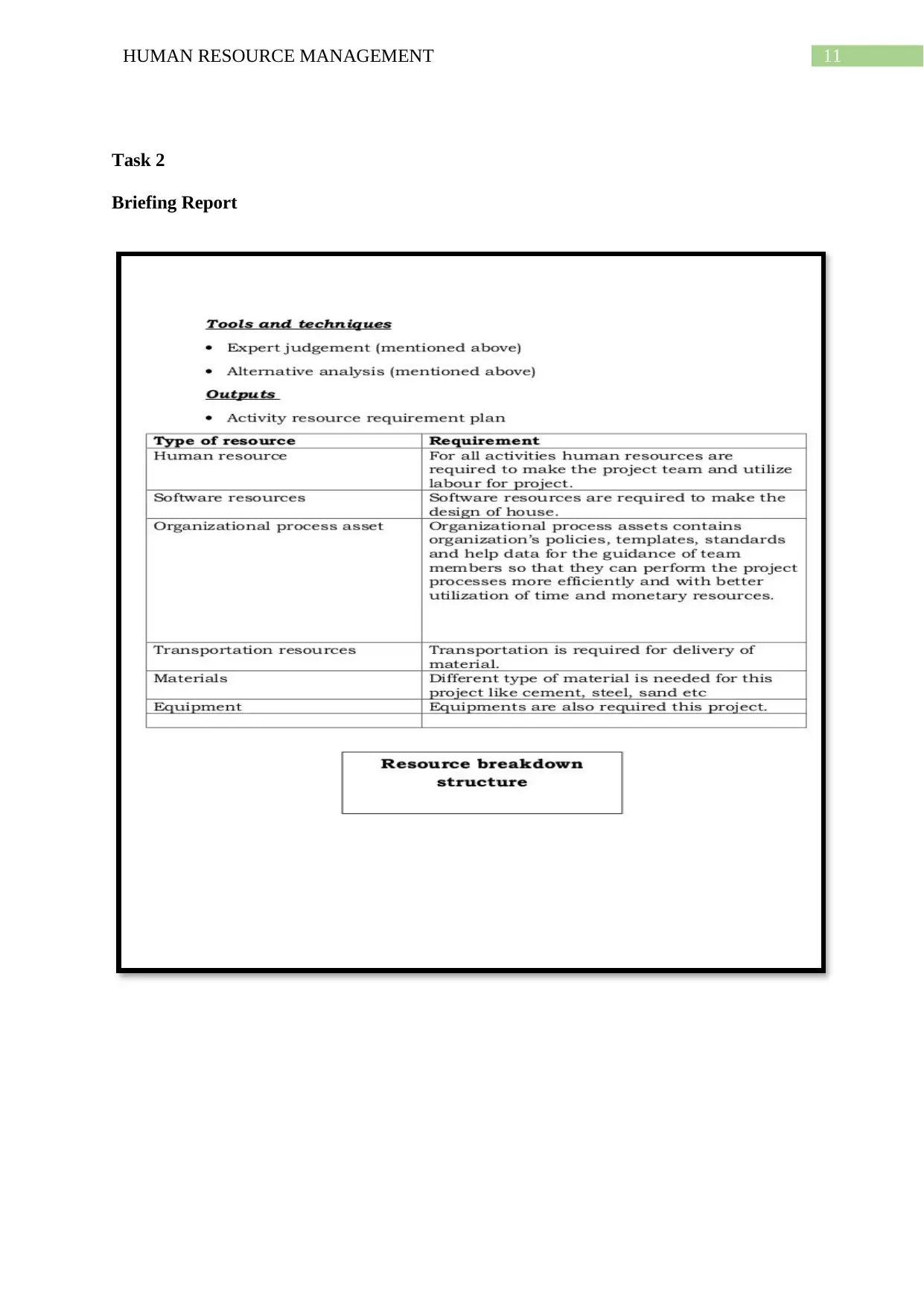
11HUMAN RESOURCE MANAGEMENT
Task 2
Briefing Report
Task 2
Briefing Report
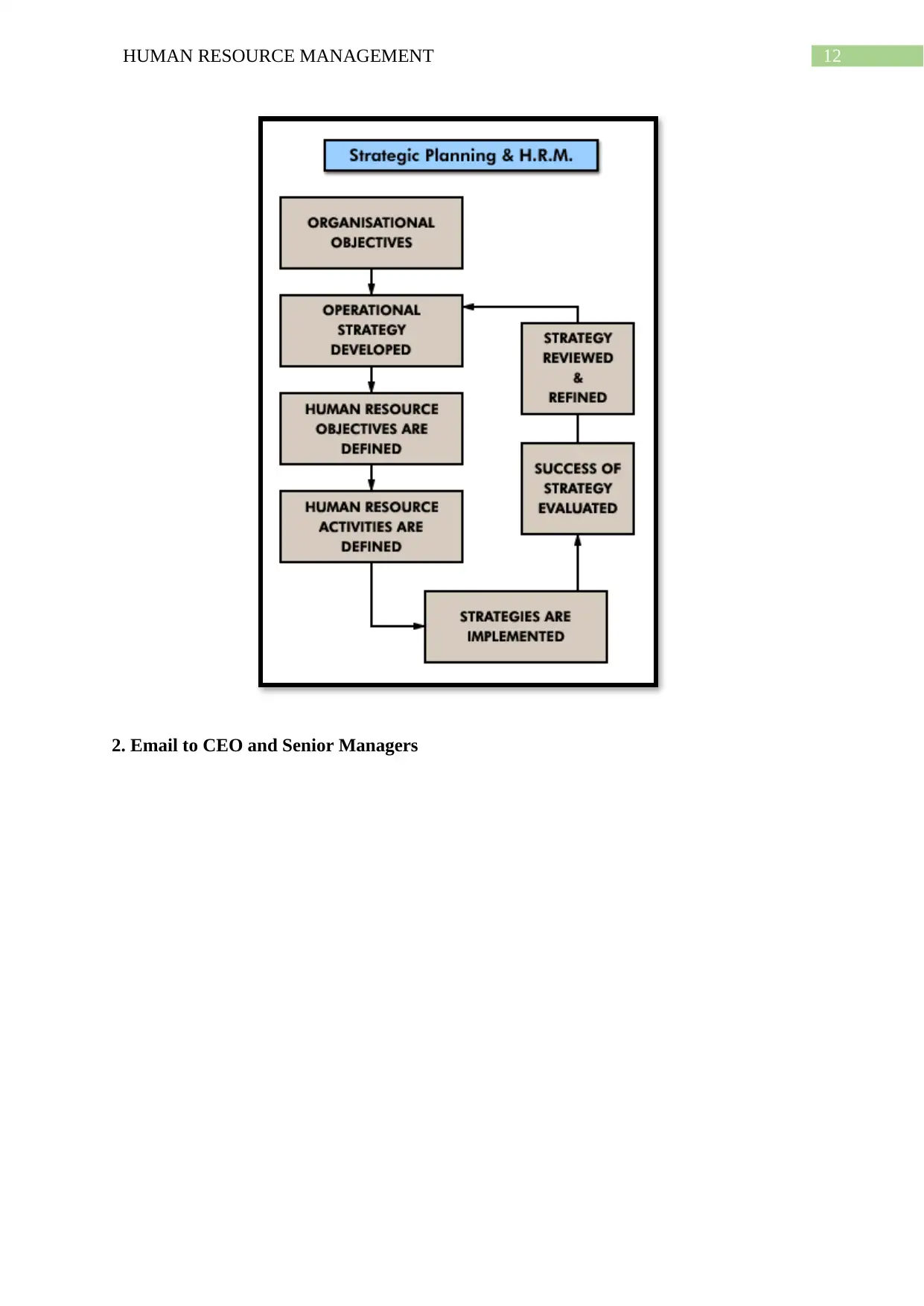
12HUMAN RESOURCE MANAGEMENT
2. Email to CEO and Senior Managers
2. Email to CEO and Senior Managers
Paraphrase This Document
Need a fresh take? Get an instant paraphrase of this document with our AI Paraphraser
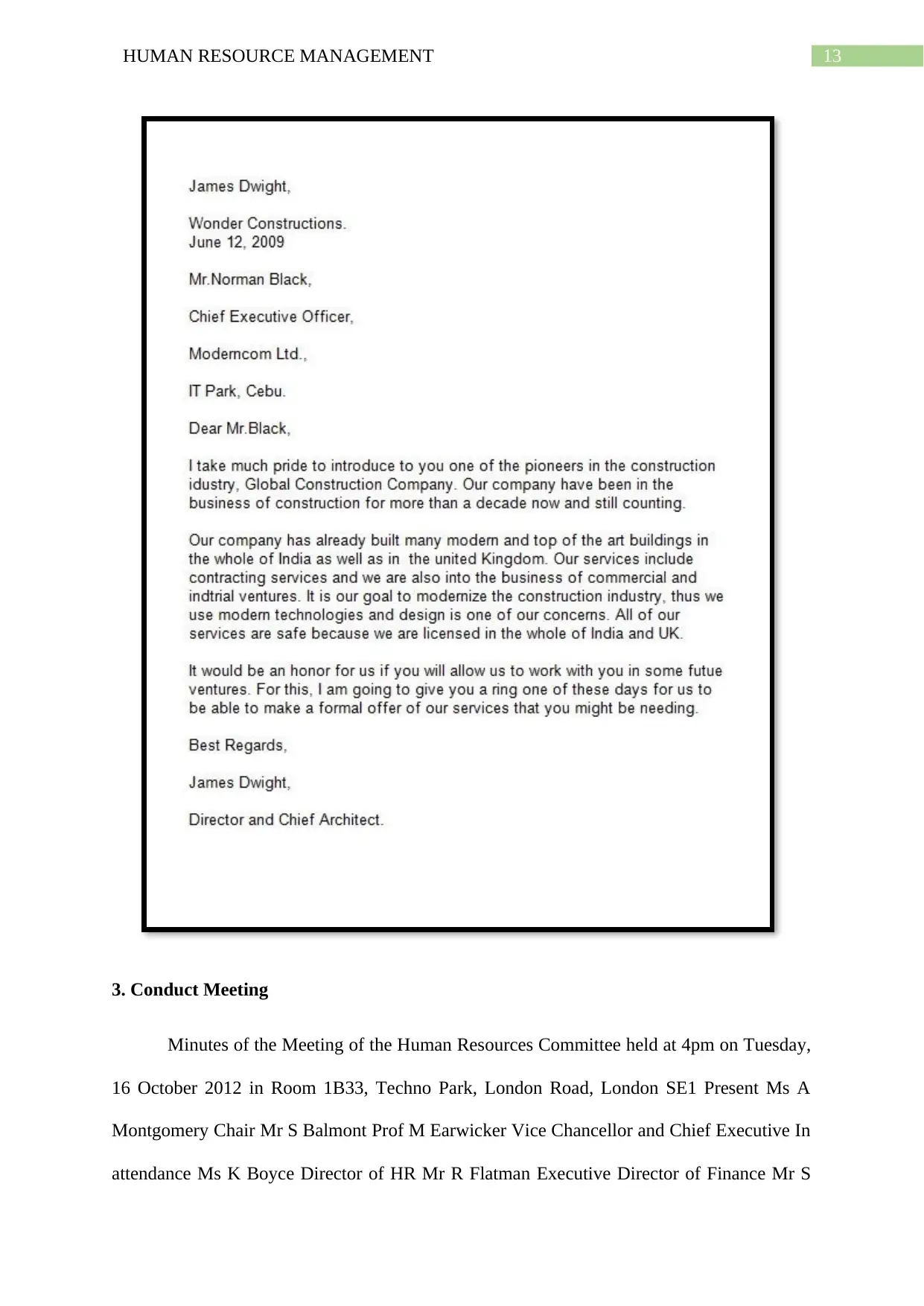
13HUMAN RESOURCE MANAGEMENT
3. Conduct Meeting
Minutes of the Meeting of the Human Resources Committee held at 4pm on Tuesday,
16 October 2012 in Room 1B33, Techno Park, London Road, London SE1 Present Ms A
Montgomery Chair Mr S Balmont Prof M Earwicker Vice Chancellor and Chief Executive In
attendance Ms K Boyce Director of HR Mr R Flatman Executive Director of Finance Mr S
3. Conduct Meeting
Minutes of the Meeting of the Human Resources Committee held at 4pm on Tuesday,
16 October 2012 in Room 1B33, Techno Park, London Road, London SE1 Present Ms A
Montgomery Chair Mr S Balmont Prof M Earwicker Vice Chancellor and Chief Executive In
attendance Ms K Boyce Director of HR Mr R Flatman Executive Director of Finance Mr S
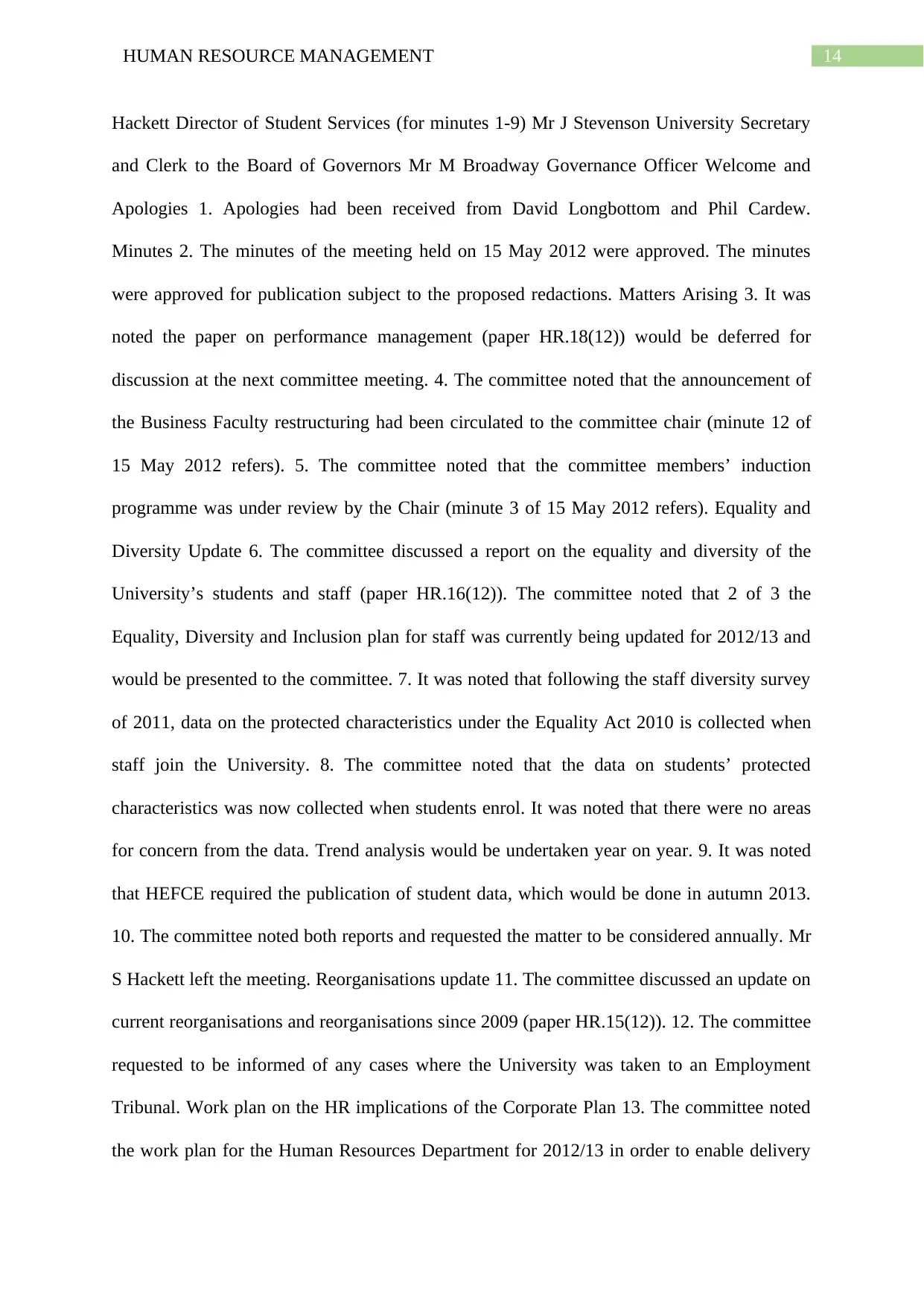
14HUMAN RESOURCE MANAGEMENT
Hackett Director of Student Services (for minutes 1-9) Mr J Stevenson University Secretary
and Clerk to the Board of Governors Mr M Broadway Governance Officer Welcome and
Apologies 1. Apologies had been received from David Longbottom and Phil Cardew.
Minutes 2. The minutes of the meeting held on 15 May 2012 were approved. The minutes
were approved for publication subject to the proposed redactions. Matters Arising 3. It was
noted the paper on performance management (paper HR.18(12)) would be deferred for
discussion at the next committee meeting. 4. The committee noted that the announcement of
the Business Faculty restructuring had been circulated to the committee chair (minute 12 of
15 May 2012 refers). 5. The committee noted that the committee members’ induction
programme was under review by the Chair (minute 3 of 15 May 2012 refers). Equality and
Diversity Update 6. The committee discussed a report on the equality and diversity of the
University’s students and staff (paper HR.16(12)). The committee noted that 2 of 3 the
Equality, Diversity and Inclusion plan for staff was currently being updated for 2012/13 and
would be presented to the committee. 7. It was noted that following the staff diversity survey
of 2011, data on the protected characteristics under the Equality Act 2010 is collected when
staff join the University. 8. The committee noted that the data on students’ protected
characteristics was now collected when students enrol. It was noted that there were no areas
for concern from the data. Trend analysis would be undertaken year on year. 9. It was noted
that HEFCE required the publication of student data, which would be done in autumn 2013.
10. The committee noted both reports and requested the matter to be considered annually. Mr
S Hackett left the meeting. Reorganisations update 11. The committee discussed an update on
current reorganisations and reorganisations since 2009 (paper HR.15(12)). 12. The committee
requested to be informed of any cases where the University was taken to an Employment
Tribunal. Work plan on the HR implications of the Corporate Plan 13. The committee noted
the work plan for the Human Resources Department for 2012/13 in order to enable delivery
Hackett Director of Student Services (for minutes 1-9) Mr J Stevenson University Secretary
and Clerk to the Board of Governors Mr M Broadway Governance Officer Welcome and
Apologies 1. Apologies had been received from David Longbottom and Phil Cardew.
Minutes 2. The minutes of the meeting held on 15 May 2012 were approved. The minutes
were approved for publication subject to the proposed redactions. Matters Arising 3. It was
noted the paper on performance management (paper HR.18(12)) would be deferred for
discussion at the next committee meeting. 4. The committee noted that the announcement of
the Business Faculty restructuring had been circulated to the committee chair (minute 12 of
15 May 2012 refers). 5. The committee noted that the committee members’ induction
programme was under review by the Chair (minute 3 of 15 May 2012 refers). Equality and
Diversity Update 6. The committee discussed a report on the equality and diversity of the
University’s students and staff (paper HR.16(12)). The committee noted that 2 of 3 the
Equality, Diversity and Inclusion plan for staff was currently being updated for 2012/13 and
would be presented to the committee. 7. It was noted that following the staff diversity survey
of 2011, data on the protected characteristics under the Equality Act 2010 is collected when
staff join the University. 8. The committee noted that the data on students’ protected
characteristics was now collected when students enrol. It was noted that there were no areas
for concern from the data. Trend analysis would be undertaken year on year. 9. It was noted
that HEFCE required the publication of student data, which would be done in autumn 2013.
10. The committee noted both reports and requested the matter to be considered annually. Mr
S Hackett left the meeting. Reorganisations update 11. The committee discussed an update on
current reorganisations and reorganisations since 2009 (paper HR.15(12)). 12. The committee
requested to be informed of any cases where the University was taken to an Employment
Tribunal. Work plan on the HR implications of the Corporate Plan 13. The committee noted
the work plan for the Human Resources Department for 2012/13 in order to enable delivery
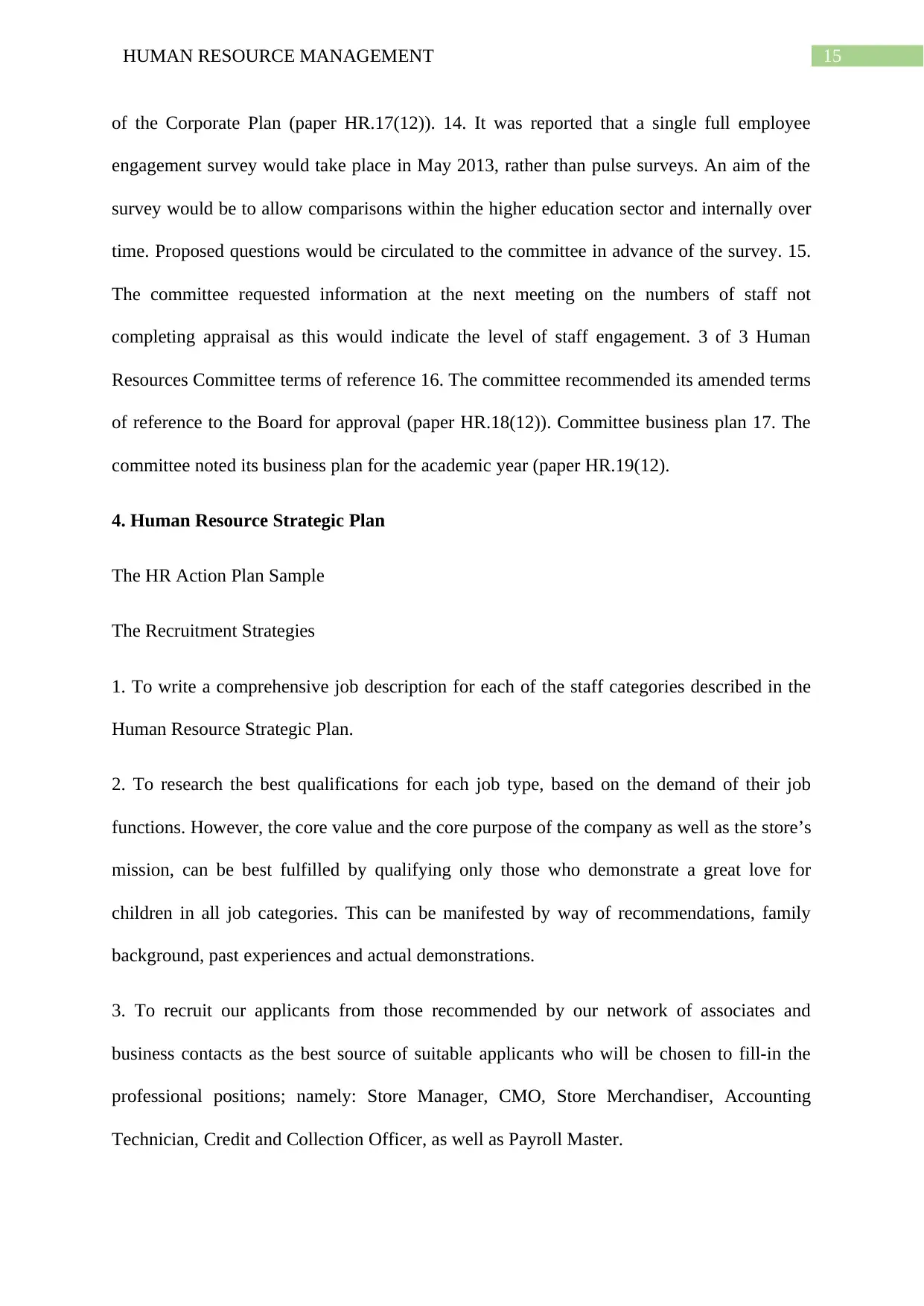
15HUMAN RESOURCE MANAGEMENT
of the Corporate Plan (paper HR.17(12)). 14. It was reported that a single full employee
engagement survey would take place in May 2013, rather than pulse surveys. An aim of the
survey would be to allow comparisons within the higher education sector and internally over
time. Proposed questions would be circulated to the committee in advance of the survey. 15.
The committee requested information at the next meeting on the numbers of staff not
completing appraisal as this would indicate the level of staff engagement. 3 of 3 Human
Resources Committee terms of reference 16. The committee recommended its amended terms
of reference to the Board for approval (paper HR.18(12)). Committee business plan 17. The
committee noted its business plan for the academic year (paper HR.19(12).
4. Human Resource Strategic Plan
The HR Action Plan Sample
The Recruitment Strategies
1. To write a comprehensive job description for each of the staff categories described in the
Human Resource Strategic Plan.
2. To research the best qualifications for each job type, based on the demand of their job
functions. However, the core value and the core purpose of the company as well as the store’s
mission, can be best fulfilled by qualifying only those who demonstrate a great love for
children in all job categories. This can be manifested by way of recommendations, family
background, past experiences and actual demonstrations.
3. To recruit our applicants from those recommended by our network of associates and
business contacts as the best source of suitable applicants who will be chosen to fill-in the
professional positions; namely: Store Manager, CMO, Store Merchandiser, Accounting
Technician, Credit and Collection Officer, as well as Payroll Master.
of the Corporate Plan (paper HR.17(12)). 14. It was reported that a single full employee
engagement survey would take place in May 2013, rather than pulse surveys. An aim of the
survey would be to allow comparisons within the higher education sector and internally over
time. Proposed questions would be circulated to the committee in advance of the survey. 15.
The committee requested information at the next meeting on the numbers of staff not
completing appraisal as this would indicate the level of staff engagement. 3 of 3 Human
Resources Committee terms of reference 16. The committee recommended its amended terms
of reference to the Board for approval (paper HR.18(12)). Committee business plan 17. The
committee noted its business plan for the academic year (paper HR.19(12).
4. Human Resource Strategic Plan
The HR Action Plan Sample
The Recruitment Strategies
1. To write a comprehensive job description for each of the staff categories described in the
Human Resource Strategic Plan.
2. To research the best qualifications for each job type, based on the demand of their job
functions. However, the core value and the core purpose of the company as well as the store’s
mission, can be best fulfilled by qualifying only those who demonstrate a great love for
children in all job categories. This can be manifested by way of recommendations, family
background, past experiences and actual demonstrations.
3. To recruit our applicants from those recommended by our network of associates and
business contacts as the best source of suitable applicants who will be chosen to fill-in the
professional positions; namely: Store Manager, CMO, Store Merchandiser, Accounting
Technician, Credit and Collection Officer, as well as Payroll Master.
Secure Best Marks with AI Grader
Need help grading? Try our AI Grader for instant feedback on your assignments.
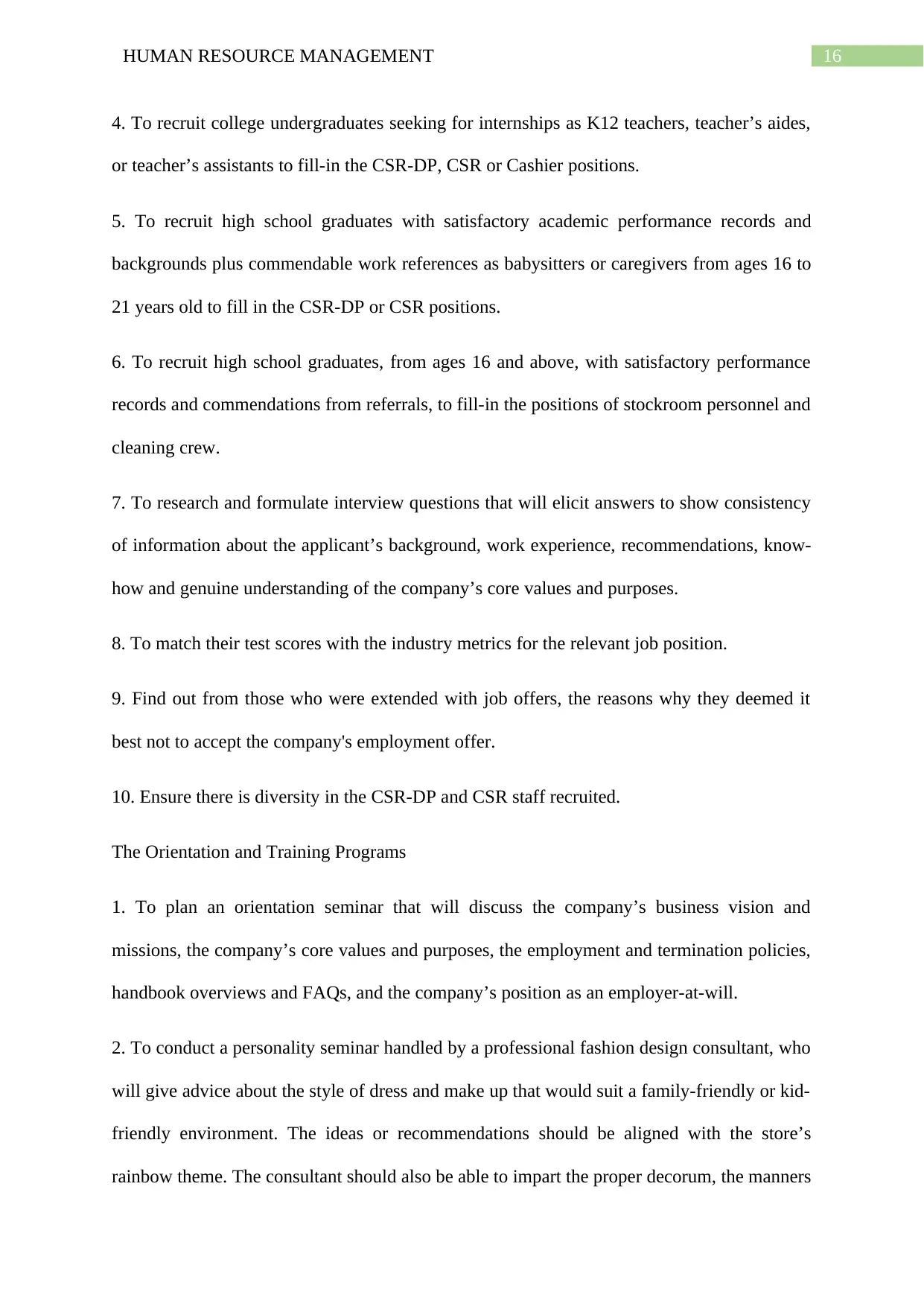
16HUMAN RESOURCE MANAGEMENT
4. To recruit college undergraduates seeking for internships as K12 teachers, teacher’s aides,
or teacher’s assistants to fill-in the CSR-DP, CSR or Cashier positions.
5. To recruit high school graduates with satisfactory academic performance records and
backgrounds plus commendable work references as babysitters or caregivers from ages 16 to
21 years old to fill in the CSR-DP or CSR positions.
6. To recruit high school graduates, from ages 16 and above, with satisfactory performance
records and commendations from referrals, to fill-in the positions of stockroom personnel and
cleaning crew.
7. To research and formulate interview questions that will elicit answers to show consistency
of information about the applicant’s background, work experience, recommendations, know-
how and genuine understanding of the company’s core values and purposes.
8. To match their test scores with the industry metrics for the relevant job position.
9. Find out from those who were extended with job offers, the reasons why they deemed it
best not to accept the company's employment offer.
10. Ensure there is diversity in the CSR-DP and CSR staff recruited.
The Orientation and Training Programs
1. To plan an orientation seminar that will discuss the company’s business vision and
missions, the company’s core values and purposes, the employment and termination policies,
handbook overviews and FAQs, and the company’s position as an employer-at-will.
2. To conduct a personality seminar handled by a professional fashion design consultant, who
will give advice about the style of dress and make up that would suit a family-friendly or kid-
friendly environment. The ideas or recommendations should be aligned with the store’s
rainbow theme. The consultant should also be able to impart the proper decorum, the manners
4. To recruit college undergraduates seeking for internships as K12 teachers, teacher’s aides,
or teacher’s assistants to fill-in the CSR-DP, CSR or Cashier positions.
5. To recruit high school graduates with satisfactory academic performance records and
backgrounds plus commendable work references as babysitters or caregivers from ages 16 to
21 years old to fill in the CSR-DP or CSR positions.
6. To recruit high school graduates, from ages 16 and above, with satisfactory performance
records and commendations from referrals, to fill-in the positions of stockroom personnel and
cleaning crew.
7. To research and formulate interview questions that will elicit answers to show consistency
of information about the applicant’s background, work experience, recommendations, know-
how and genuine understanding of the company’s core values and purposes.
8. To match their test scores with the industry metrics for the relevant job position.
9. Find out from those who were extended with job offers, the reasons why they deemed it
best not to accept the company's employment offer.
10. Ensure there is diversity in the CSR-DP and CSR staff recruited.
The Orientation and Training Programs
1. To plan an orientation seminar that will discuss the company’s business vision and
missions, the company’s core values and purposes, the employment and termination policies,
handbook overviews and FAQs, and the company’s position as an employer-at-will.
2. To conduct a personality seminar handled by a professional fashion design consultant, who
will give advice about the style of dress and make up that would suit a family-friendly or kid-
friendly environment. The ideas or recommendations should be aligned with the store’s
rainbow theme. The consultant should also be able to impart the proper decorum, the manners
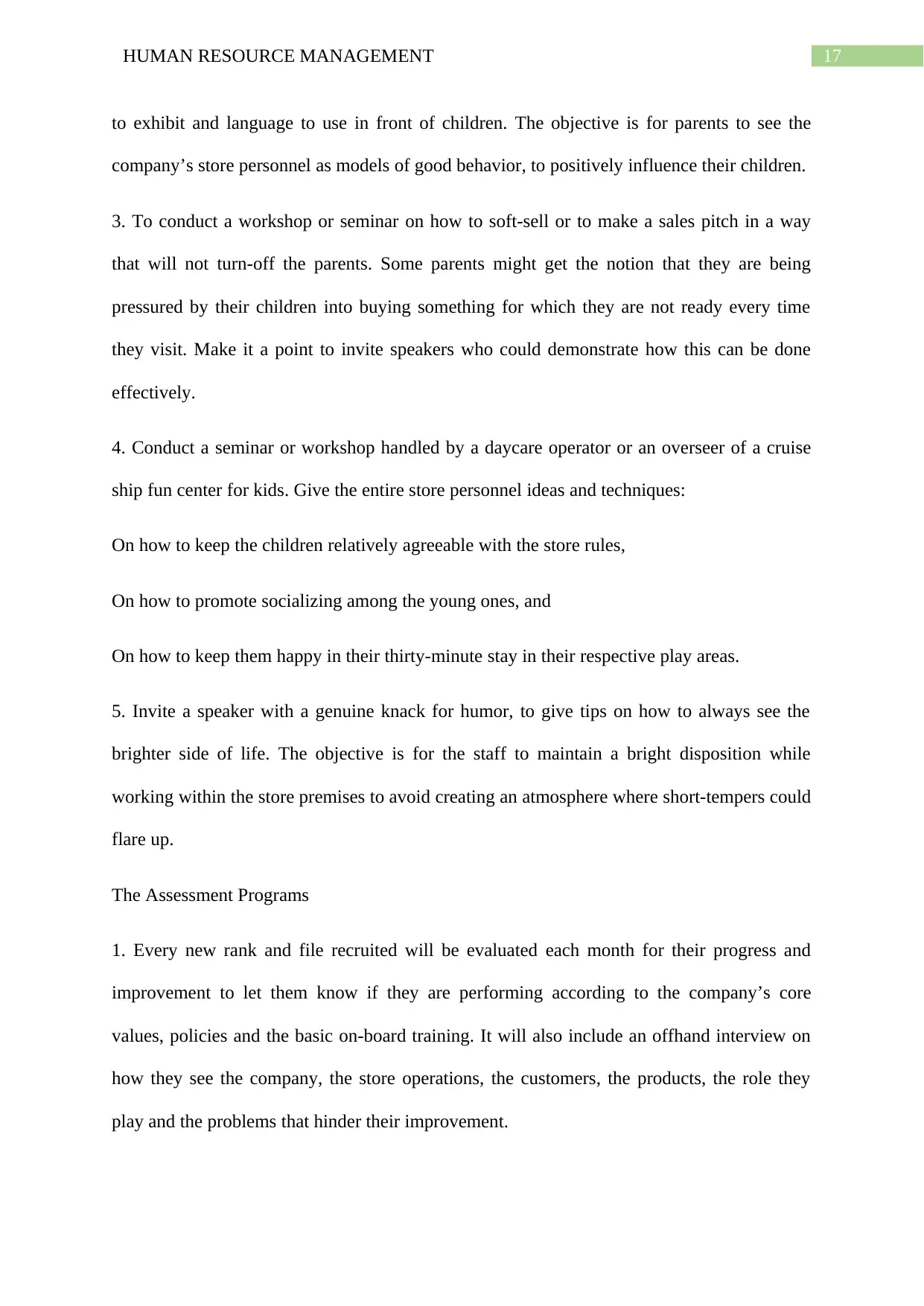
17HUMAN RESOURCE MANAGEMENT
to exhibit and language to use in front of children. The objective is for parents to see the
company’s store personnel as models of good behavior, to positively influence their children.
3. To conduct a workshop or seminar on how to soft-sell or to make a sales pitch in a way
that will not turn-off the parents. Some parents might get the notion that they are being
pressured by their children into buying something for which they are not ready every time
they visit. Make it a point to invite speakers who could demonstrate how this can be done
effectively.
4. Conduct a seminar or workshop handled by a daycare operator or an overseer of a cruise
ship fun center for kids. Give the entire store personnel ideas and techniques:
On how to keep the children relatively agreeable with the store rules,
On how to promote socializing among the young ones, and
On how to keep them happy in their thirty-minute stay in their respective play areas.
5. Invite a speaker with a genuine knack for humor, to give tips on how to always see the
brighter side of life. The objective is for the staff to maintain a bright disposition while
working within the store premises to avoid creating an atmosphere where short-tempers could
flare up.
The Assessment Programs
1. Every new rank and file recruited will be evaluated each month for their progress and
improvement to let them know if they are performing according to the company’s core
values, policies and the basic on-board training. It will also include an offhand interview on
how they see the company, the store operations, the customers, the products, the role they
play and the problems that hinder their improvement.
to exhibit and language to use in front of children. The objective is for parents to see the
company’s store personnel as models of good behavior, to positively influence their children.
3. To conduct a workshop or seminar on how to soft-sell or to make a sales pitch in a way
that will not turn-off the parents. Some parents might get the notion that they are being
pressured by their children into buying something for which they are not ready every time
they visit. Make it a point to invite speakers who could demonstrate how this can be done
effectively.
4. Conduct a seminar or workshop handled by a daycare operator or an overseer of a cruise
ship fun center for kids. Give the entire store personnel ideas and techniques:
On how to keep the children relatively agreeable with the store rules,
On how to promote socializing among the young ones, and
On how to keep them happy in their thirty-minute stay in their respective play areas.
5. Invite a speaker with a genuine knack for humor, to give tips on how to always see the
brighter side of life. The objective is for the staff to maintain a bright disposition while
working within the store premises to avoid creating an atmosphere where short-tempers could
flare up.
The Assessment Programs
1. Every new rank and file recruited will be evaluated each month for their progress and
improvement to let them know if they are performing according to the company’s core
values, policies and the basic on-board training. It will also include an offhand interview on
how they see the company, the store operations, the customers, the products, the role they
play and the problems that hinder their improvement.
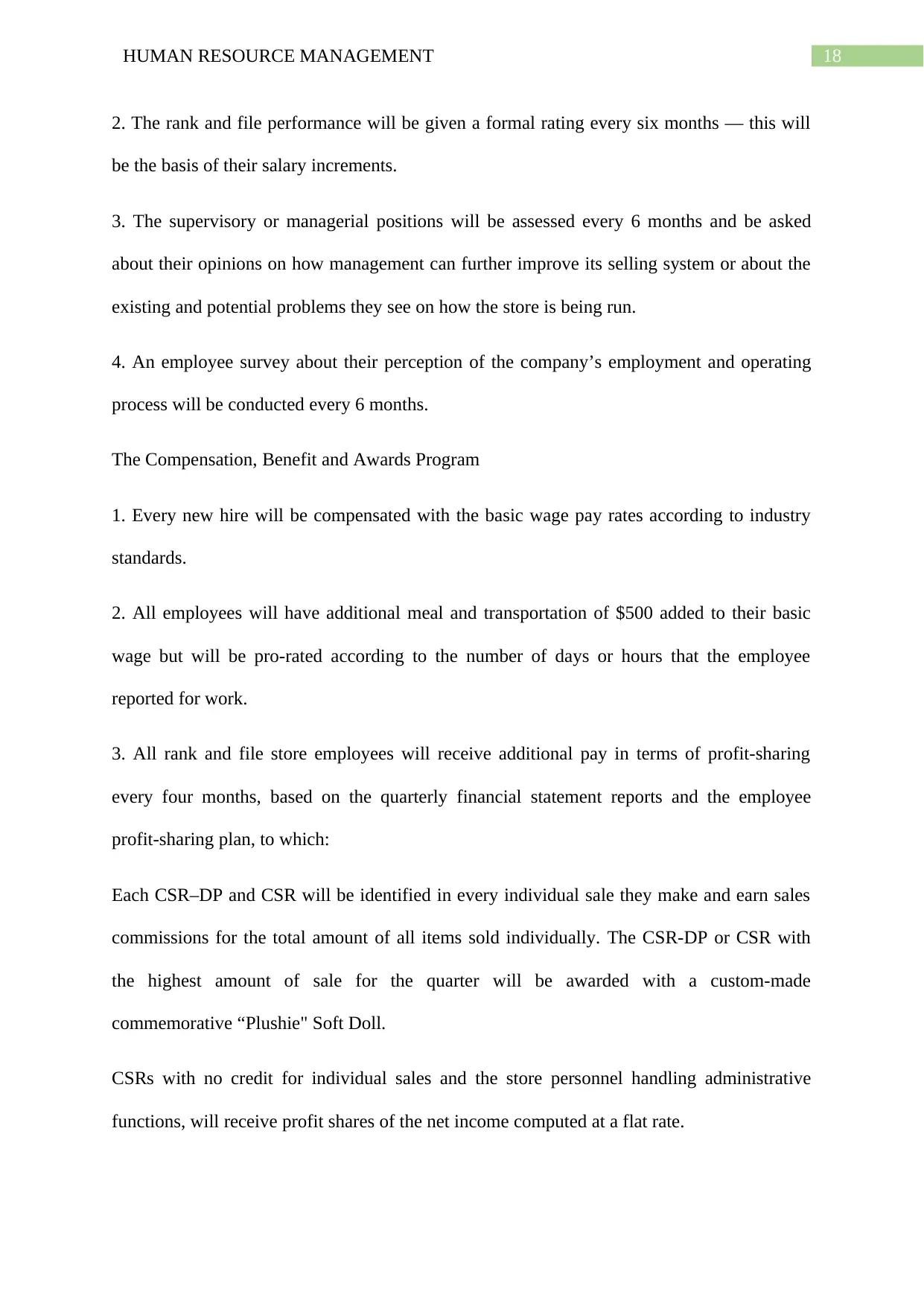
18HUMAN RESOURCE MANAGEMENT
2. The rank and file performance will be given a formal rating every six months — this will
be the basis of their salary increments.
3. The supervisory or managerial positions will be assessed every 6 months and be asked
about their opinions on how management can further improve its selling system or about the
existing and potential problems they see on how the store is being run.
4. An employee survey about their perception of the company’s employment and operating
process will be conducted every 6 months.
The Compensation, Benefit and Awards Program
1. Every new hire will be compensated with the basic wage pay rates according to industry
standards.
2. All employees will have additional meal and transportation of $500 added to their basic
wage but will be pro-rated according to the number of days or hours that the employee
reported for work.
3. All rank and file store employees will receive additional pay in terms of profit-sharing
every four months, based on the quarterly financial statement reports and the employee
profit-sharing plan, to which:
Each CSR–DP and CSR will be identified in every individual sale they make and earn sales
commissions for the total amount of all items sold individually. The CSR-DP or CSR with
the highest amount of sale for the quarter will be awarded with a custom-made
commemorative “Plushie" Soft Doll.
CSRs with no credit for individual sales and the store personnel handling administrative
functions, will receive profit shares of the net income computed at a flat rate.
2. The rank and file performance will be given a formal rating every six months — this will
be the basis of their salary increments.
3. The supervisory or managerial positions will be assessed every 6 months and be asked
about their opinions on how management can further improve its selling system or about the
existing and potential problems they see on how the store is being run.
4. An employee survey about their perception of the company’s employment and operating
process will be conducted every 6 months.
The Compensation, Benefit and Awards Program
1. Every new hire will be compensated with the basic wage pay rates according to industry
standards.
2. All employees will have additional meal and transportation of $500 added to their basic
wage but will be pro-rated according to the number of days or hours that the employee
reported for work.
3. All rank and file store employees will receive additional pay in terms of profit-sharing
every four months, based on the quarterly financial statement reports and the employee
profit-sharing plan, to which:
Each CSR–DP and CSR will be identified in every individual sale they make and earn sales
commissions for the total amount of all items sold individually. The CSR-DP or CSR with
the highest amount of sale for the quarter will be awarded with a custom-made
commemorative “Plushie" Soft Doll.
CSRs with no credit for individual sales and the store personnel handling administrative
functions, will receive profit shares of the net income computed at a flat rate.
Paraphrase This Document
Need a fresh take? Get an instant paraphrase of this document with our AI Paraphraser
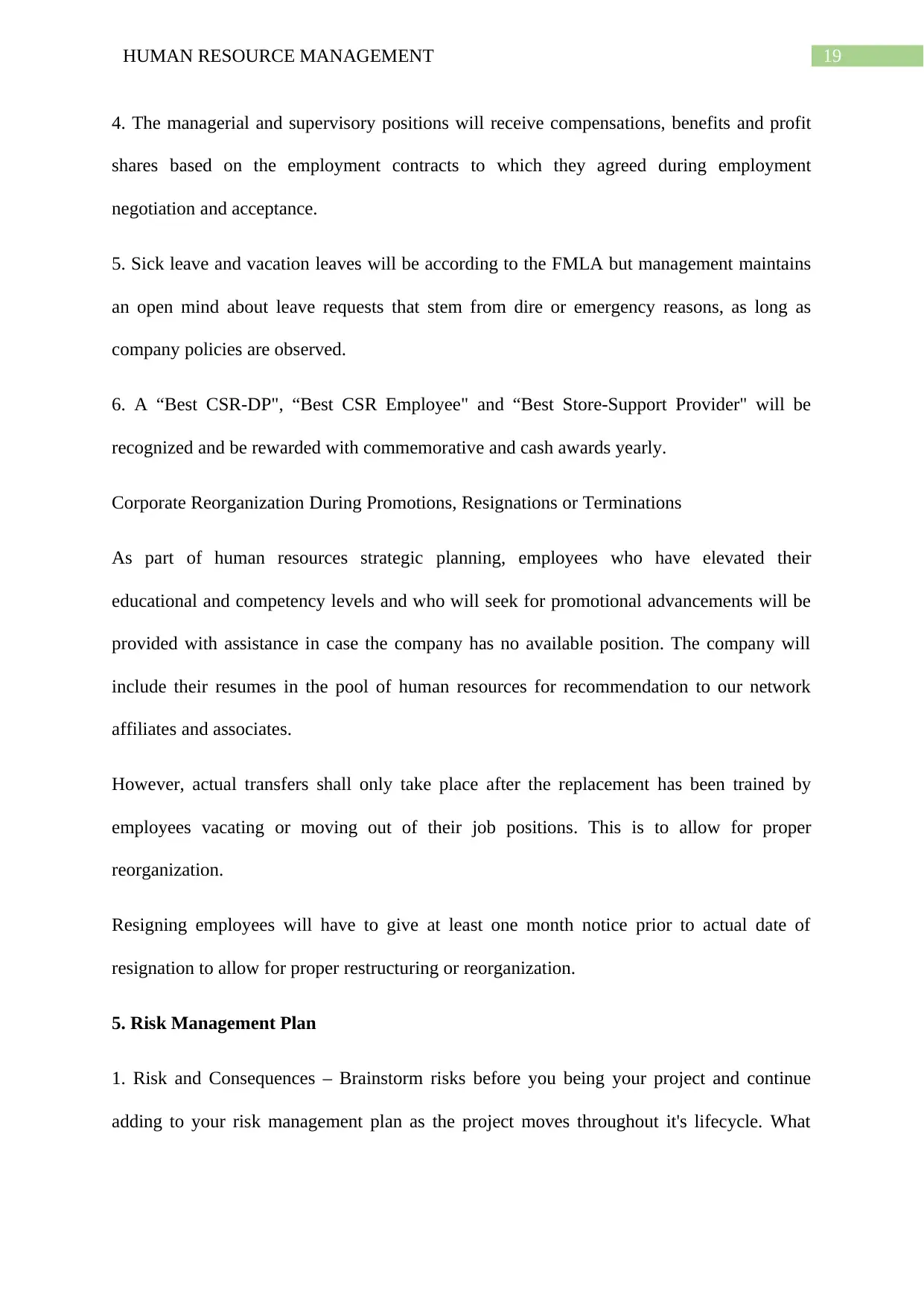
19HUMAN RESOURCE MANAGEMENT
4. The managerial and supervisory positions will receive compensations, benefits and profit
shares based on the employment contracts to which they agreed during employment
negotiation and acceptance.
5. Sick leave and vacation leaves will be according to the FMLA but management maintains
an open mind about leave requests that stem from dire or emergency reasons, as long as
company policies are observed.
6. A “Best CSR-DP", “Best CSR Employee" and “Best Store-Support Provider" will be
recognized and be rewarded with commemorative and cash awards yearly.
Corporate Reorganization During Promotions, Resignations or Terminations
As part of human resources strategic planning, employees who have elevated their
educational and competency levels and who will seek for promotional advancements will be
provided with assistance in case the company has no available position. The company will
include their resumes in the pool of human resources for recommendation to our network
affiliates and associates.
However, actual transfers shall only take place after the replacement has been trained by
employees vacating or moving out of their job positions. This is to allow for proper
reorganization.
Resigning employees will have to give at least one month notice prior to actual date of
resignation to allow for proper restructuring or reorganization.
5. Risk Management Plan
1. Risk and Consequences – Brainstorm risks before you being your project and continue
adding to your risk management plan as the project moves throughout it's lifecycle. What
4. The managerial and supervisory positions will receive compensations, benefits and profit
shares based on the employment contracts to which they agreed during employment
negotiation and acceptance.
5. Sick leave and vacation leaves will be according to the FMLA but management maintains
an open mind about leave requests that stem from dire or emergency reasons, as long as
company policies are observed.
6. A “Best CSR-DP", “Best CSR Employee" and “Best Store-Support Provider" will be
recognized and be rewarded with commemorative and cash awards yearly.
Corporate Reorganization During Promotions, Resignations or Terminations
As part of human resources strategic planning, employees who have elevated their
educational and competency levels and who will seek for promotional advancements will be
provided with assistance in case the company has no available position. The company will
include their resumes in the pool of human resources for recommendation to our network
affiliates and associates.
However, actual transfers shall only take place after the replacement has been trained by
employees vacating or moving out of their job positions. This is to allow for proper
reorganization.
Resigning employees will have to give at least one month notice prior to actual date of
resignation to allow for proper restructuring or reorganization.
5. Risk Management Plan
1. Risk and Consequences – Brainstorm risks before you being your project and continue
adding to your risk management plan as the project moves throughout it's lifecycle. What
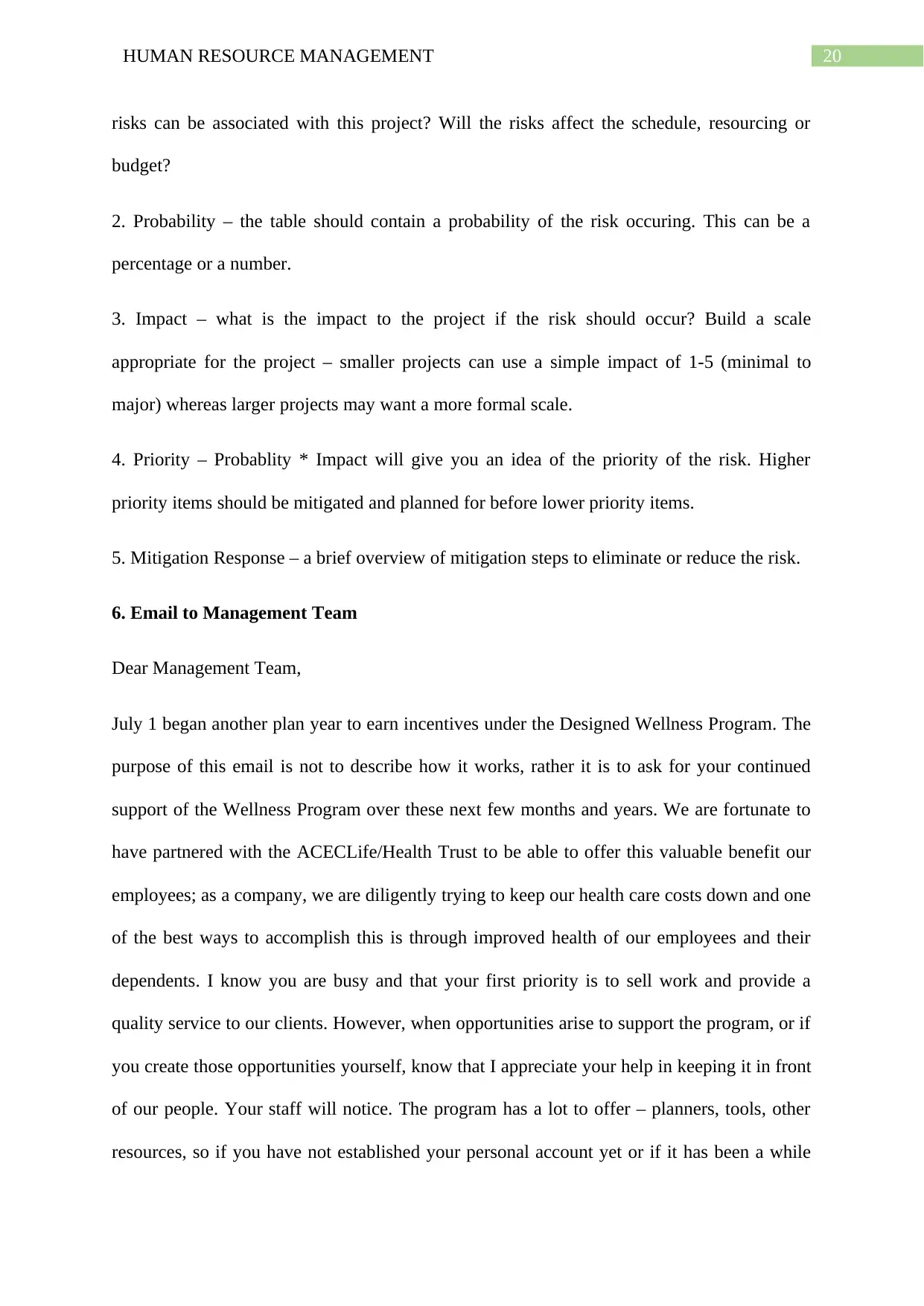
20HUMAN RESOURCE MANAGEMENT
risks can be associated with this project? Will the risks affect the schedule, resourcing or
budget?
2. Probability – the table should contain a probability of the risk occuring. This can be a
percentage or a number.
3. Impact – what is the impact to the project if the risk should occur? Build a scale
appropriate for the project – smaller projects can use a simple impact of 1-5 (minimal to
major) whereas larger projects may want a more formal scale.
4. Priority – Probablity * Impact will give you an idea of the priority of the risk. Higher
priority items should be mitigated and planned for before lower priority items.
5. Mitigation Response – a brief overview of mitigation steps to eliminate or reduce the risk.
6. Email to Management Team
Dear Management Team,
July 1 began another plan year to earn incentives under the Designed Wellness Program. The
purpose of this email is not to describe how it works, rather it is to ask for your continued
support of the Wellness Program over these next few months and years. We are fortunate to
have partnered with the ACECLife/Health Trust to be able to offer this valuable benefit our
employees; as a company, we are diligently trying to keep our health care costs down and one
of the best ways to accomplish this is through improved health of our employees and their
dependents. I know you are busy and that your first priority is to sell work and provide a
quality service to our clients. However, when opportunities arise to support the program, or if
you create those opportunities yourself, know that I appreciate your help in keeping it in front
of our people. Your staff will notice. The program has a lot to offer – planners, tools, other
resources, so if you have not established your personal account yet or if it has been a while
risks can be associated with this project? Will the risks affect the schedule, resourcing or
budget?
2. Probability – the table should contain a probability of the risk occuring. This can be a
percentage or a number.
3. Impact – what is the impact to the project if the risk should occur? Build a scale
appropriate for the project – smaller projects can use a simple impact of 1-5 (minimal to
major) whereas larger projects may want a more formal scale.
4. Priority – Probablity * Impact will give you an idea of the priority of the risk. Higher
priority items should be mitigated and planned for before lower priority items.
5. Mitigation Response – a brief overview of mitigation steps to eliminate or reduce the risk.
6. Email to Management Team
Dear Management Team,
July 1 began another plan year to earn incentives under the Designed Wellness Program. The
purpose of this email is not to describe how it works, rather it is to ask for your continued
support of the Wellness Program over these next few months and years. We are fortunate to
have partnered with the ACECLife/Health Trust to be able to offer this valuable benefit our
employees; as a company, we are diligently trying to keep our health care costs down and one
of the best ways to accomplish this is through improved health of our employees and their
dependents. I know you are busy and that your first priority is to sell work and provide a
quality service to our clients. However, when opportunities arise to support the program, or if
you create those opportunities yourself, know that I appreciate your help in keeping it in front
of our people. Your staff will notice. The program has a lot to offer – planners, tools, other
resources, so if you have not established your personal account yet or if it has been a while
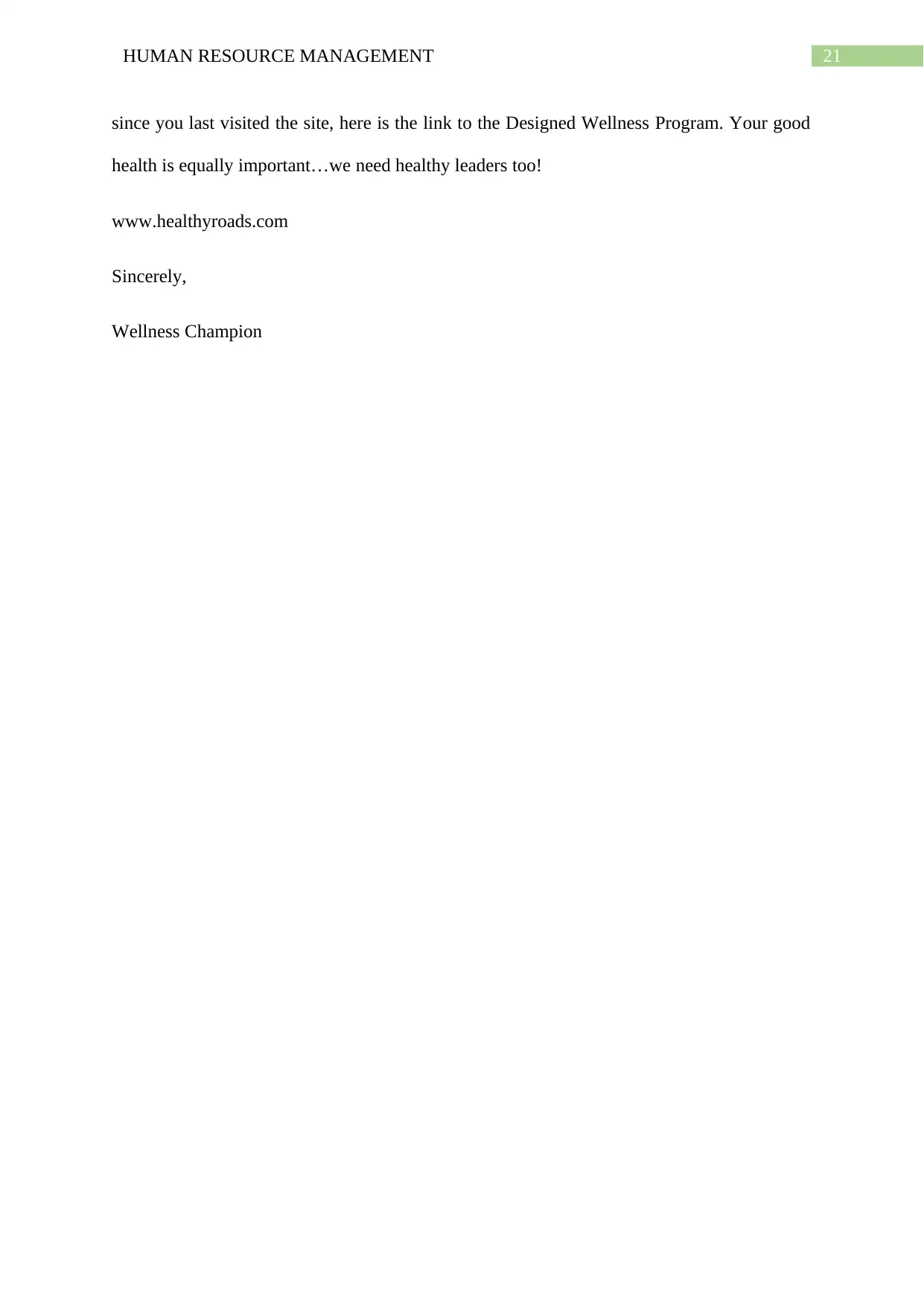
21HUMAN RESOURCE MANAGEMENT
since you last visited the site, here is the link to the Designed Wellness Program. Your good
health is equally important…we need healthy leaders too!
www.healthyroads.com
Sincerely,
Wellness Champion
since you last visited the site, here is the link to the Designed Wellness Program. Your good
health is equally important…we need healthy leaders too!
www.healthyroads.com
Sincerely,
Wellness Champion
Secure Best Marks with AI Grader
Need help grading? Try our AI Grader for instant feedback on your assignments.
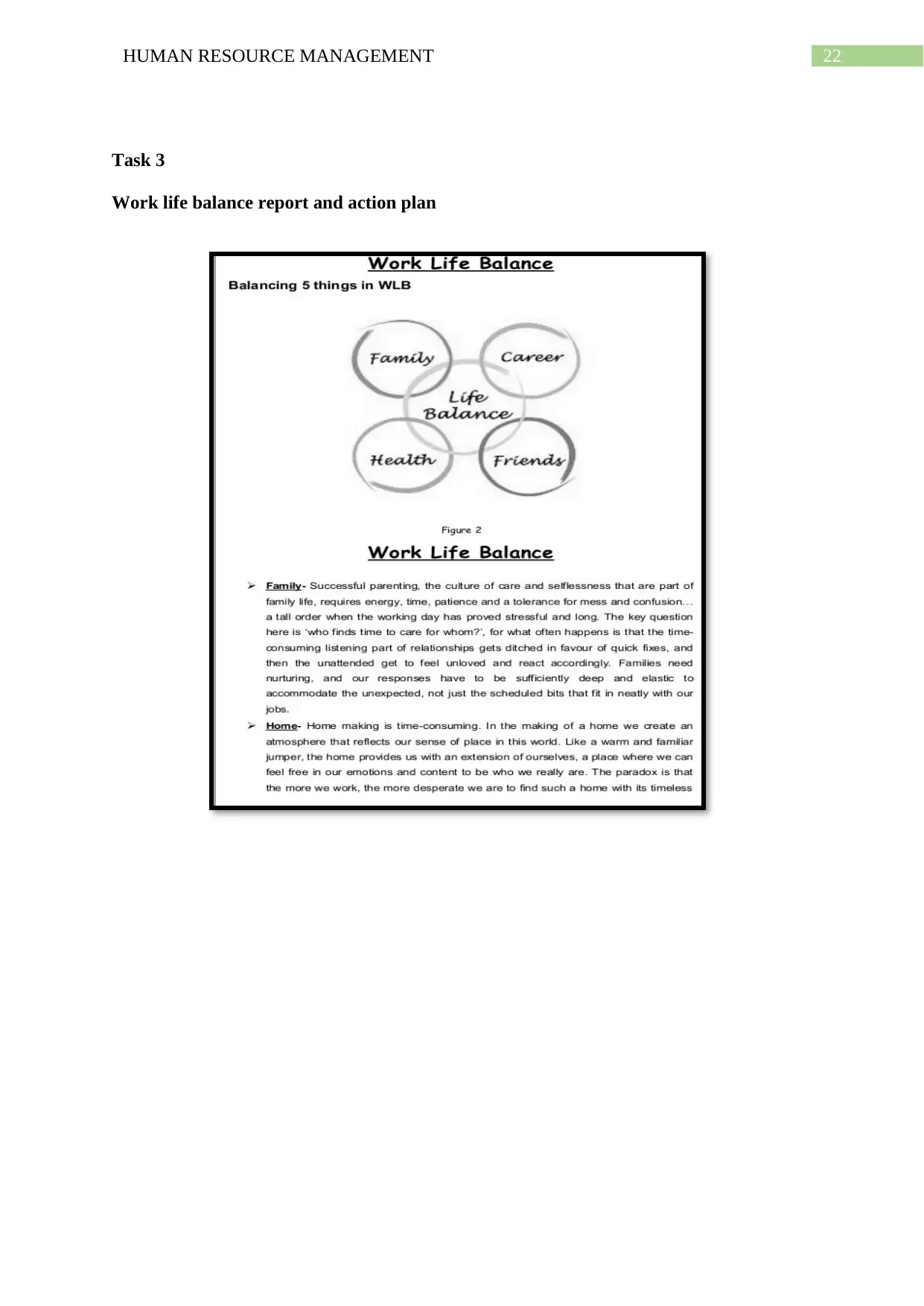
22HUMAN RESOURCE MANAGEMENT
Task 3
Work life balance report and action plan
Task 3
Work life balance report and action plan
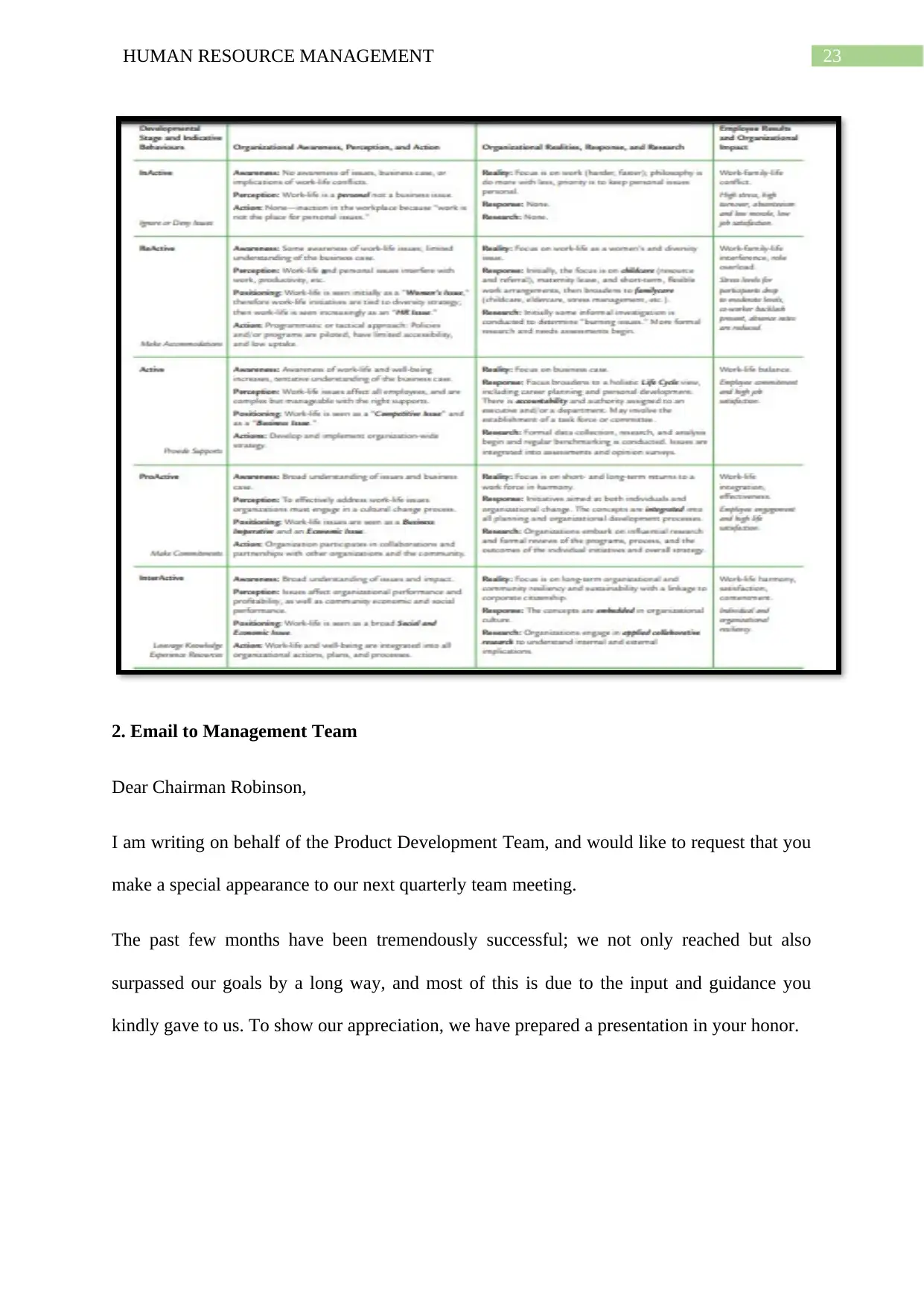
23HUMAN RESOURCE MANAGEMENT
2. Email to Management Team
Dear Chairman Robinson,
I am writing on behalf of the Product Development Team, and would like to request that you
make a special appearance to our next quarterly team meeting.
The past few months have been tremendously successful; we not only reached but also
surpassed our goals by a long way, and most of this is due to the input and guidance you
kindly gave to us. To show our appreciation, we have prepared a presentation in your honor.
2. Email to Management Team
Dear Chairman Robinson,
I am writing on behalf of the Product Development Team, and would like to request that you
make a special appearance to our next quarterly team meeting.
The past few months have been tremendously successful; we not only reached but also
surpassed our goals by a long way, and most of this is due to the input and guidance you
kindly gave to us. To show our appreciation, we have prepared a presentation in your honor.
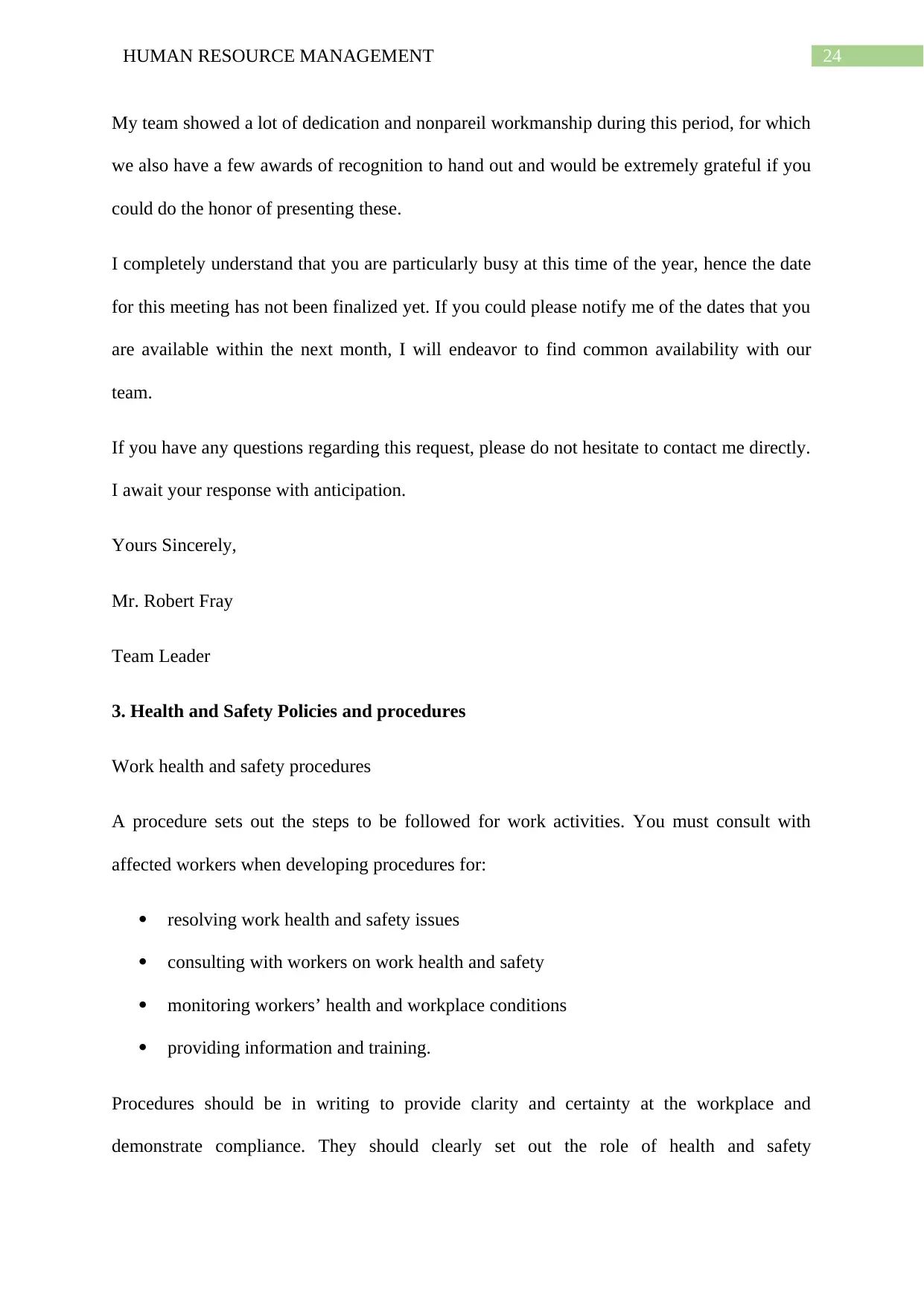
24HUMAN RESOURCE MANAGEMENT
My team showed a lot of dedication and nonpareil workmanship during this period, for which
we also have a few awards of recognition to hand out and would be extremely grateful if you
could do the honor of presenting these.
I completely understand that you are particularly busy at this time of the year, hence the date
for this meeting has not been finalized yet. If you could please notify me of the dates that you
are available within the next month, I will endeavor to find common availability with our
team.
If you have any questions regarding this request, please do not hesitate to contact me directly.
I await your response with anticipation.
Yours Sincerely,
Mr. Robert Fray
Team Leader
3. Health and Safety Policies and procedures
Work health and safety procedures
A procedure sets out the steps to be followed for work activities. You must consult with
affected workers when developing procedures for:
resolving work health and safety issues
consulting with workers on work health and safety
monitoring workers’ health and workplace conditions
providing information and training.
Procedures should be in writing to provide clarity and certainty at the workplace and
demonstrate compliance. They should clearly set out the role of health and safety
My team showed a lot of dedication and nonpareil workmanship during this period, for which
we also have a few awards of recognition to hand out and would be extremely grateful if you
could do the honor of presenting these.
I completely understand that you are particularly busy at this time of the year, hence the date
for this meeting has not been finalized yet. If you could please notify me of the dates that you
are available within the next month, I will endeavor to find common availability with our
team.
If you have any questions regarding this request, please do not hesitate to contact me directly.
I await your response with anticipation.
Yours Sincerely,
Mr. Robert Fray
Team Leader
3. Health and Safety Policies and procedures
Work health and safety procedures
A procedure sets out the steps to be followed for work activities. You must consult with
affected workers when developing procedures for:
resolving work health and safety issues
consulting with workers on work health and safety
monitoring workers’ health and workplace conditions
providing information and training.
Procedures should be in writing to provide clarity and certainty at the workplace and
demonstrate compliance. They should clearly set out the role of health and safety
Paraphrase This Document
Need a fresh take? Get an instant paraphrase of this document with our AI Paraphraser
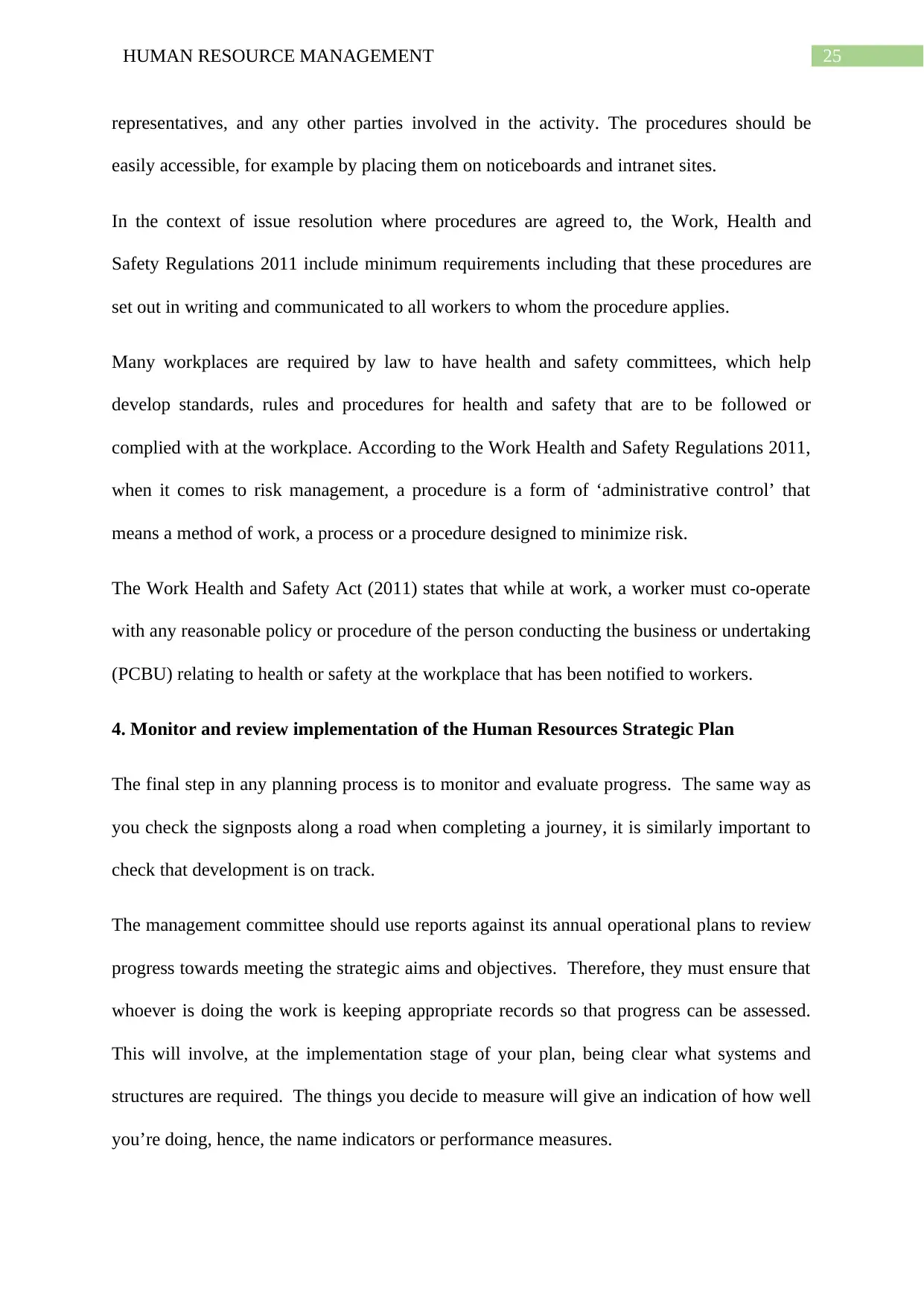
25HUMAN RESOURCE MANAGEMENT
representatives, and any other parties involved in the activity. The procedures should be
easily accessible, for example by placing them on noticeboards and intranet sites.
In the context of issue resolution where procedures are agreed to, the Work, Health and
Safety Regulations 2011 include minimum requirements including that these procedures are
set out in writing and communicated to all workers to whom the procedure applies.
Many workplaces are required by law to have health and safety committees, which help
develop standards, rules and procedures for health and safety that are to be followed or
complied with at the workplace. According to the Work Health and Safety Regulations 2011,
when it comes to risk management, a procedure is a form of ‘administrative control’ that
means a method of work, a process or a procedure designed to minimize risk.
The Work Health and Safety Act (2011) states that while at work, a worker must co-operate
with any reasonable policy or procedure of the person conducting the business or undertaking
(PCBU) relating to health or safety at the workplace that has been notified to workers.
4. Monitor and review implementation of the Human Resources Strategic Plan
The final step in any planning process is to monitor and evaluate progress. The same way as
you check the signposts along a road when completing a journey, it is similarly important to
check that development is on track.
The management committee should use reports against its annual operational plans to review
progress towards meeting the strategic aims and objectives. Therefore, they must ensure that
whoever is doing the work is keeping appropriate records so that progress can be assessed.
This will involve, at the implementation stage of your plan, being clear what systems and
structures are required. The things you decide to measure will give an indication of how well
you’re doing, hence, the name indicators or performance measures.
representatives, and any other parties involved in the activity. The procedures should be
easily accessible, for example by placing them on noticeboards and intranet sites.
In the context of issue resolution where procedures are agreed to, the Work, Health and
Safety Regulations 2011 include minimum requirements including that these procedures are
set out in writing and communicated to all workers to whom the procedure applies.
Many workplaces are required by law to have health and safety committees, which help
develop standards, rules and procedures for health and safety that are to be followed or
complied with at the workplace. According to the Work Health and Safety Regulations 2011,
when it comes to risk management, a procedure is a form of ‘administrative control’ that
means a method of work, a process or a procedure designed to minimize risk.
The Work Health and Safety Act (2011) states that while at work, a worker must co-operate
with any reasonable policy or procedure of the person conducting the business or undertaking
(PCBU) relating to health or safety at the workplace that has been notified to workers.
4. Monitor and review implementation of the Human Resources Strategic Plan
The final step in any planning process is to monitor and evaluate progress. The same way as
you check the signposts along a road when completing a journey, it is similarly important to
check that development is on track.
The management committee should use reports against its annual operational plans to review
progress towards meeting the strategic aims and objectives. Therefore, they must ensure that
whoever is doing the work is keeping appropriate records so that progress can be assessed.
This will involve, at the implementation stage of your plan, being clear what systems and
structures are required. The things you decide to measure will give an indication of how well
you’re doing, hence, the name indicators or performance measures.
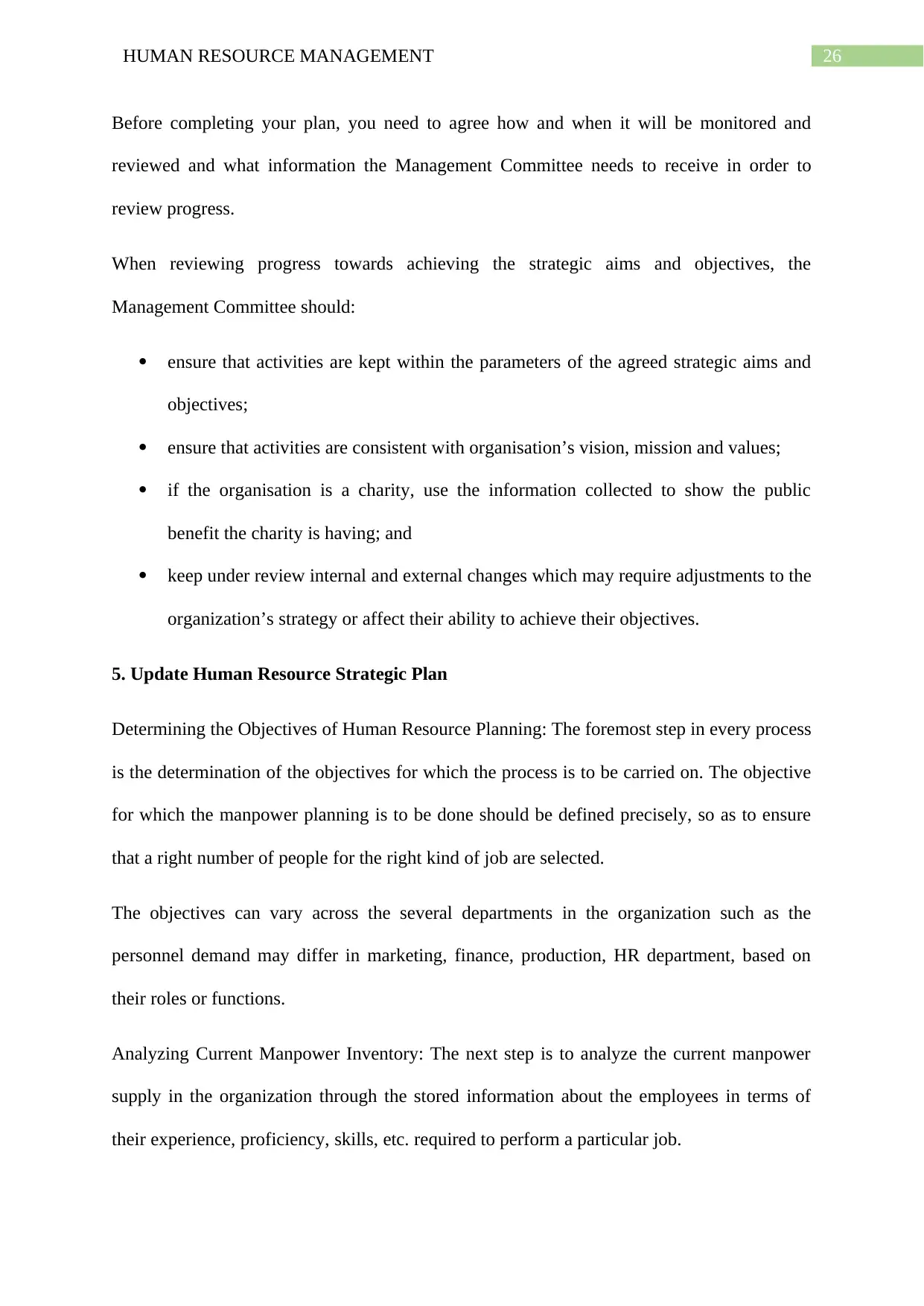
26HUMAN RESOURCE MANAGEMENT
Before completing your plan, you need to agree how and when it will be monitored and
reviewed and what information the Management Committee needs to receive in order to
review progress.
When reviewing progress towards achieving the strategic aims and objectives, the
Management Committee should:
ensure that activities are kept within the parameters of the agreed strategic aims and
objectives;
ensure that activities are consistent with organisation’s vision, mission and values;
if the organisation is a charity, use the information collected to show the public
benefit the charity is having; and
keep under review internal and external changes which may require adjustments to the
organization’s strategy or affect their ability to achieve their objectives.
5. Update Human Resource Strategic Plan
Determining the Objectives of Human Resource Planning: The foremost step in every process
is the determination of the objectives for which the process is to be carried on. The objective
for which the manpower planning is to be done should be defined precisely, so as to ensure
that a right number of people for the right kind of job are selected.
The objectives can vary across the several departments in the organization such as the
personnel demand may differ in marketing, finance, production, HR department, based on
their roles or functions.
Analyzing Current Manpower Inventory: The next step is to analyze the current manpower
supply in the organization through the stored information about the employees in terms of
their experience, proficiency, skills, etc. required to perform a particular job.
Before completing your plan, you need to agree how and when it will be monitored and
reviewed and what information the Management Committee needs to receive in order to
review progress.
When reviewing progress towards achieving the strategic aims and objectives, the
Management Committee should:
ensure that activities are kept within the parameters of the agreed strategic aims and
objectives;
ensure that activities are consistent with organisation’s vision, mission and values;
if the organisation is a charity, use the information collected to show the public
benefit the charity is having; and
keep under review internal and external changes which may require adjustments to the
organization’s strategy or affect their ability to achieve their objectives.
5. Update Human Resource Strategic Plan
Determining the Objectives of Human Resource Planning: The foremost step in every process
is the determination of the objectives for which the process is to be carried on. The objective
for which the manpower planning is to be done should be defined precisely, so as to ensure
that a right number of people for the right kind of job are selected.
The objectives can vary across the several departments in the organization such as the
personnel demand may differ in marketing, finance, production, HR department, based on
their roles or functions.
Analyzing Current Manpower Inventory: The next step is to analyze the current manpower
supply in the organization through the stored information about the employees in terms of
their experience, proficiency, skills, etc. required to perform a particular job.
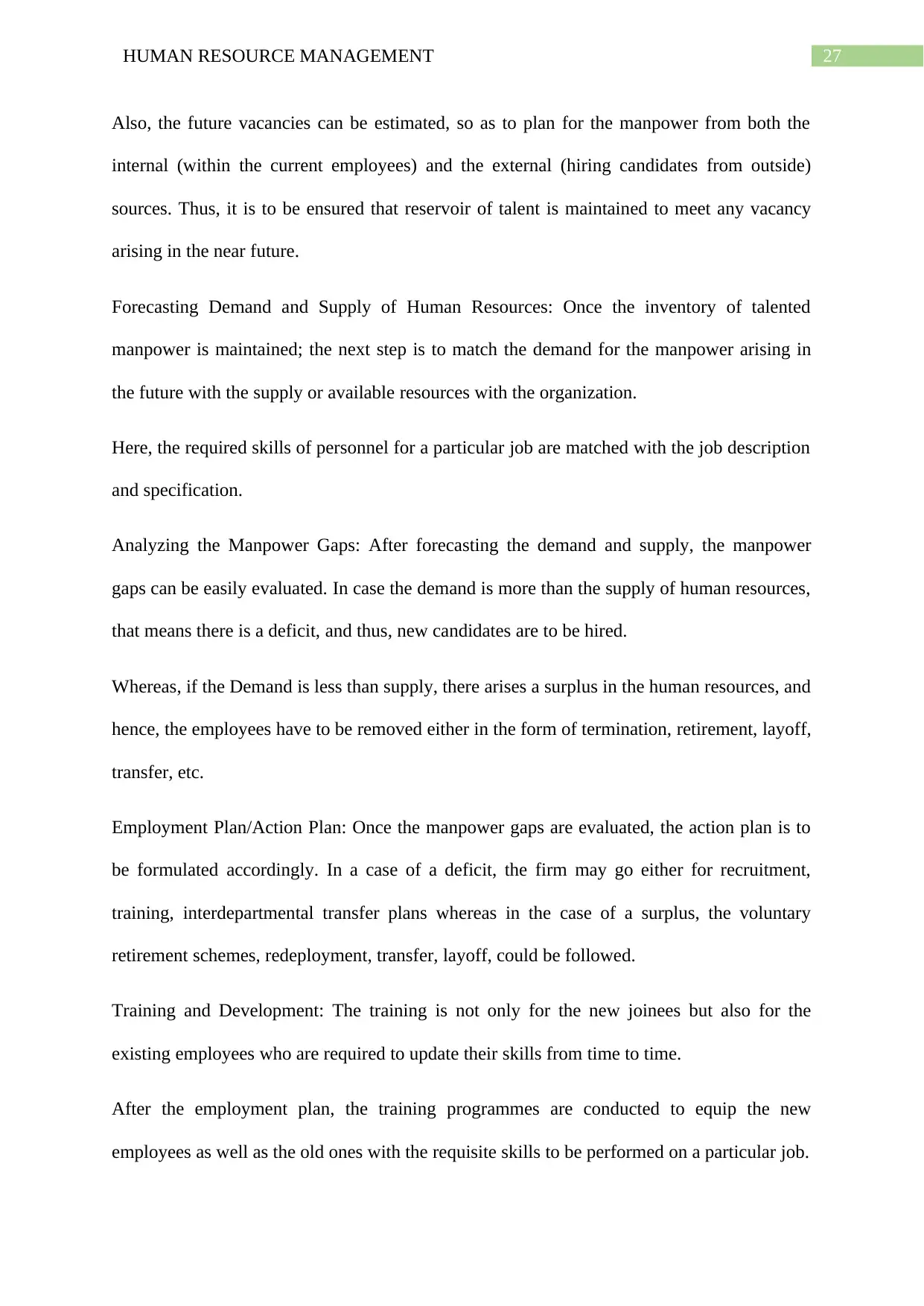
27HUMAN RESOURCE MANAGEMENT
Also, the future vacancies can be estimated, so as to plan for the manpower from both the
internal (within the current employees) and the external (hiring candidates from outside)
sources. Thus, it is to be ensured that reservoir of talent is maintained to meet any vacancy
arising in the near future.
Forecasting Demand and Supply of Human Resources: Once the inventory of talented
manpower is maintained; the next step is to match the demand for the manpower arising in
the future with the supply or available resources with the organization.
Here, the required skills of personnel for a particular job are matched with the job description
and specification.
Analyzing the Manpower Gaps: After forecasting the demand and supply, the manpower
gaps can be easily evaluated. In case the demand is more than the supply of human resources,
that means there is a deficit, and thus, new candidates are to be hired.
Whereas, if the Demand is less than supply, there arises a surplus in the human resources, and
hence, the employees have to be removed either in the form of termination, retirement, layoff,
transfer, etc.
Employment Plan/Action Plan: Once the manpower gaps are evaluated, the action plan is to
be formulated accordingly. In a case of a deficit, the firm may go either for recruitment,
training, interdepartmental transfer plans whereas in the case of a surplus, the voluntary
retirement schemes, redeployment, transfer, layoff, could be followed.
Training and Development: The training is not only for the new joinees but also for the
existing employees who are required to update their skills from time to time.
After the employment plan, the training programmes are conducted to equip the new
employees as well as the old ones with the requisite skills to be performed on a particular job.
Also, the future vacancies can be estimated, so as to plan for the manpower from both the
internal (within the current employees) and the external (hiring candidates from outside)
sources. Thus, it is to be ensured that reservoir of talent is maintained to meet any vacancy
arising in the near future.
Forecasting Demand and Supply of Human Resources: Once the inventory of talented
manpower is maintained; the next step is to match the demand for the manpower arising in
the future with the supply or available resources with the organization.
Here, the required skills of personnel for a particular job are matched with the job description
and specification.
Analyzing the Manpower Gaps: After forecasting the demand and supply, the manpower
gaps can be easily evaluated. In case the demand is more than the supply of human resources,
that means there is a deficit, and thus, new candidates are to be hired.
Whereas, if the Demand is less than supply, there arises a surplus in the human resources, and
hence, the employees have to be removed either in the form of termination, retirement, layoff,
transfer, etc.
Employment Plan/Action Plan: Once the manpower gaps are evaluated, the action plan is to
be formulated accordingly. In a case of a deficit, the firm may go either for recruitment,
training, interdepartmental transfer plans whereas in the case of a surplus, the voluntary
retirement schemes, redeployment, transfer, layoff, could be followed.
Training and Development: The training is not only for the new joinees but also for the
existing employees who are required to update their skills from time to time.
After the employment plan, the training programmes are conducted to equip the new
employees as well as the old ones with the requisite skills to be performed on a particular job.
Secure Best Marks with AI Grader
Need help grading? Try our AI Grader for instant feedback on your assignments.
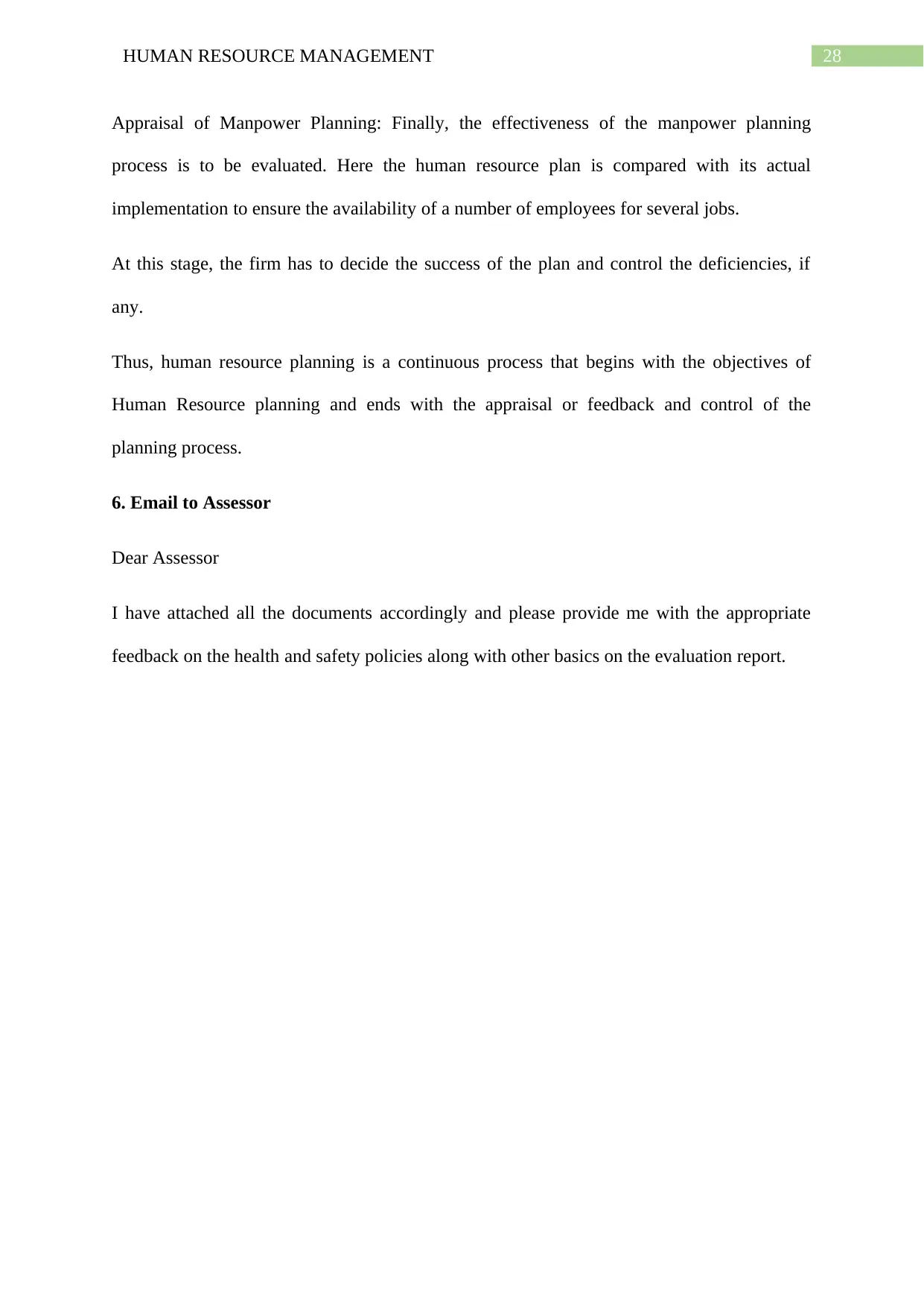
28HUMAN RESOURCE MANAGEMENT
Appraisal of Manpower Planning: Finally, the effectiveness of the manpower planning
process is to be evaluated. Here the human resource plan is compared with its actual
implementation to ensure the availability of a number of employees for several jobs.
At this stage, the firm has to decide the success of the plan and control the deficiencies, if
any.
Thus, human resource planning is a continuous process that begins with the objectives of
Human Resource planning and ends with the appraisal or feedback and control of the
planning process.
6. Email to Assessor
Dear Assessor
I have attached all the documents accordingly and please provide me with the appropriate
feedback on the health and safety policies along with other basics on the evaluation report.
Appraisal of Manpower Planning: Finally, the effectiveness of the manpower planning
process is to be evaluated. Here the human resource plan is compared with its actual
implementation to ensure the availability of a number of employees for several jobs.
At this stage, the firm has to decide the success of the plan and control the deficiencies, if
any.
Thus, human resource planning is a continuous process that begins with the objectives of
Human Resource planning and ends with the appraisal or feedback and control of the
planning process.
6. Email to Assessor
Dear Assessor
I have attached all the documents accordingly and please provide me with the appropriate
feedback on the health and safety policies along with other basics on the evaluation report.
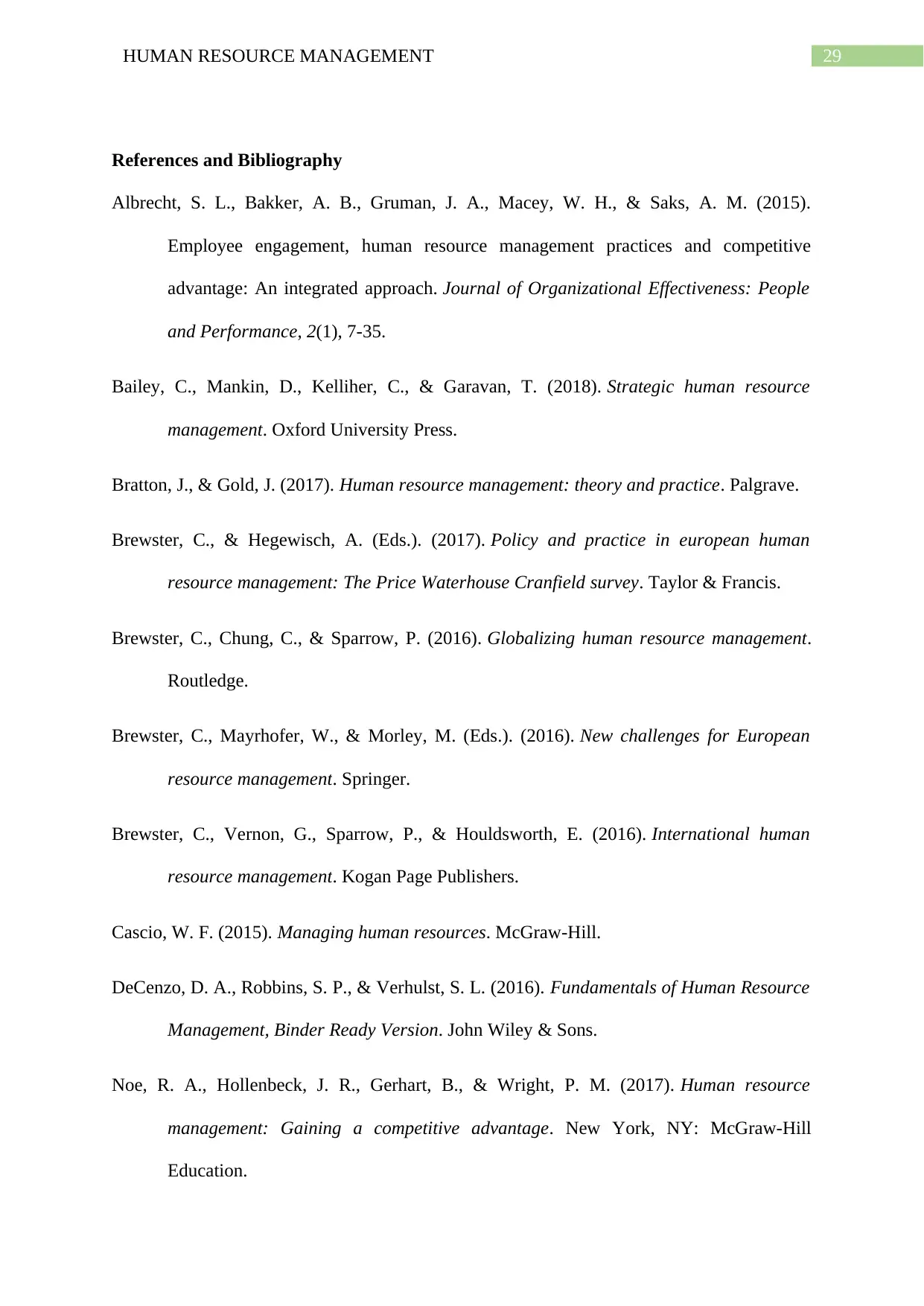
29HUMAN RESOURCE MANAGEMENT
References and Bibliography
Albrecht, S. L., Bakker, A. B., Gruman, J. A., Macey, W. H., & Saks, A. M. (2015).
Employee engagement, human resource management practices and competitive
advantage: An integrated approach. Journal of Organizational Effectiveness: People
and Performance, 2(1), 7-35.
Bailey, C., Mankin, D., Kelliher, C., & Garavan, T. (2018). Strategic human resource
management. Oxford University Press.
Bratton, J., & Gold, J. (2017). Human resource management: theory and practice. Palgrave.
Brewster, C., & Hegewisch, A. (Eds.). (2017). Policy and practice in european human
resource management: The Price Waterhouse Cranfield survey. Taylor & Francis.
Brewster, C., Chung, C., & Sparrow, P. (2016). Globalizing human resource management.
Routledge.
Brewster, C., Mayrhofer, W., & Morley, M. (Eds.). (2016). New challenges for European
resource management. Springer.
Brewster, C., Vernon, G., Sparrow, P., & Houldsworth, E. (2016). International human
resource management. Kogan Page Publishers.
Cascio, W. F. (2015). Managing human resources. McGraw-Hill.
DeCenzo, D. A., Robbins, S. P., & Verhulst, S. L. (2016). Fundamentals of Human Resource
Management, Binder Ready Version. John Wiley & Sons.
Noe, R. A., Hollenbeck, J. R., Gerhart, B., & Wright, P. M. (2017). Human resource
management: Gaining a competitive advantage. New York, NY: McGraw-Hill
Education.
References and Bibliography
Albrecht, S. L., Bakker, A. B., Gruman, J. A., Macey, W. H., & Saks, A. M. (2015).
Employee engagement, human resource management practices and competitive
advantage: An integrated approach. Journal of Organizational Effectiveness: People
and Performance, 2(1), 7-35.
Bailey, C., Mankin, D., Kelliher, C., & Garavan, T. (2018). Strategic human resource
management. Oxford University Press.
Bratton, J., & Gold, J. (2017). Human resource management: theory and practice. Palgrave.
Brewster, C., & Hegewisch, A. (Eds.). (2017). Policy and practice in european human
resource management: The Price Waterhouse Cranfield survey. Taylor & Francis.
Brewster, C., Chung, C., & Sparrow, P. (2016). Globalizing human resource management.
Routledge.
Brewster, C., Mayrhofer, W., & Morley, M. (Eds.). (2016). New challenges for European
resource management. Springer.
Brewster, C., Vernon, G., Sparrow, P., & Houldsworth, E. (2016). International human
resource management. Kogan Page Publishers.
Cascio, W. F. (2015). Managing human resources. McGraw-Hill.
DeCenzo, D. A., Robbins, S. P., & Verhulst, S. L. (2016). Fundamentals of Human Resource
Management, Binder Ready Version. John Wiley & Sons.
Noe, R. A., Hollenbeck, J. R., Gerhart, B., & Wright, P. M. (2017). Human resource
management: Gaining a competitive advantage. New York, NY: McGraw-Hill
Education.
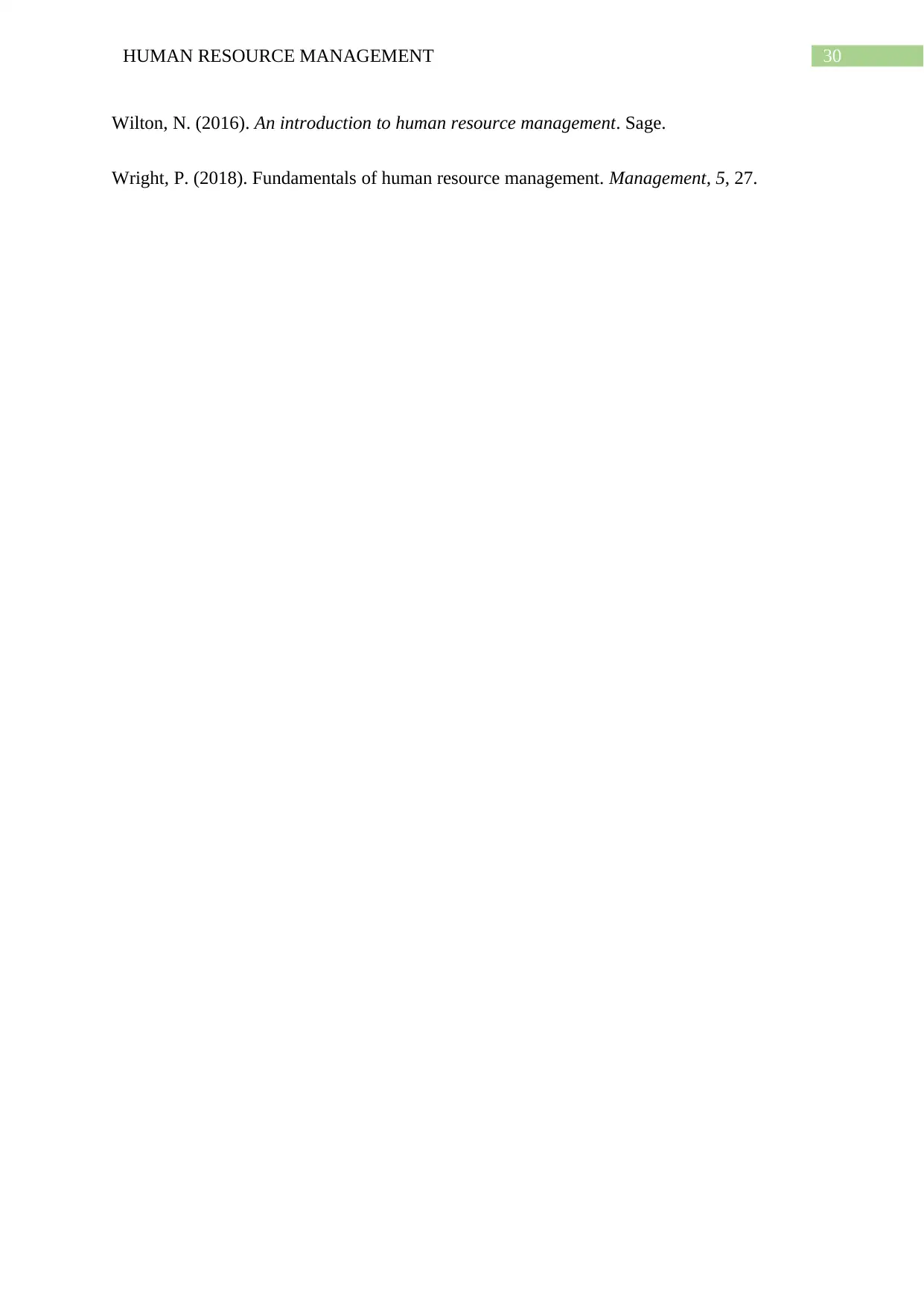
30HUMAN RESOURCE MANAGEMENT
Wilton, N. (2016). An introduction to human resource management. Sage.
Wright, P. (2018). Fundamentals of human resource management. Management, 5, 27.
Wilton, N. (2016). An introduction to human resource management. Sage.
Wright, P. (2018). Fundamentals of human resource management. Management, 5, 27.
1 out of 31
Related Documents
Your All-in-One AI-Powered Toolkit for Academic Success.
+13062052269
info@desklib.com
Available 24*7 on WhatsApp / Email
![[object Object]](/_next/static/media/star-bottom.7253800d.svg)
Unlock your academic potential
© 2024 | Zucol Services PVT LTD | All rights reserved.




